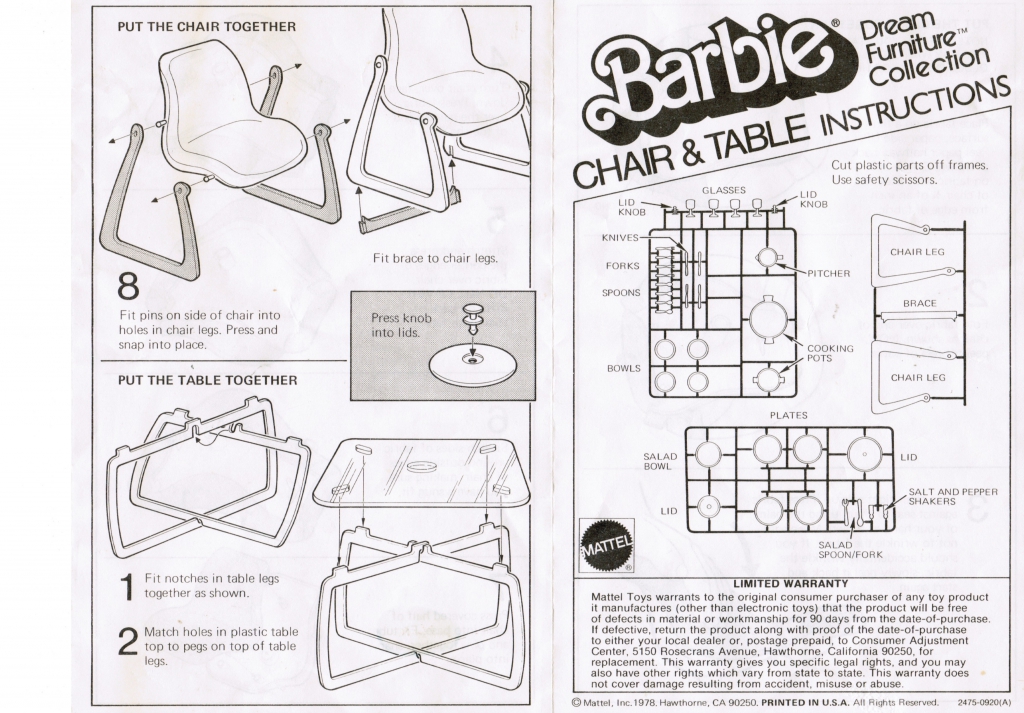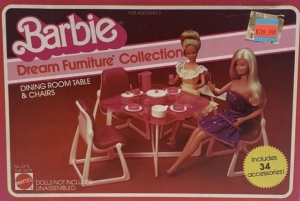Playful Dining
Playful Dining
An on-line exhibition originally scheduled to open April 30, 2024 but delayed until June 30 due to IMoDD’s relocation
While the International Museum of Dinnerware Design’s permanent collections were being carefully packed for the museum’s relocation from Ann Arbor, Michigan, to Kingston, New York, the virtual on-line only exhibition, Playful Dining, was to be offered as a celebration of dining history for the young and young at heart. While the virtual exhibition’s opening was delayed due to the physical move, it is available now, and it unabashedly offers something for everyone’s interpretation of what “playful dining” is all about.
Our selection of dozens of examples of playful dining from the IMoDD permanent collection, are accompanied by informative and insightful essays by collector and scholar Scott Vermillion. His contribution surpasses that of the curator who merely selected the objects.
The exhibition is mostly about toy dish sets (some in their original boxes!) enjoyed by children of bygone eras including amber Depression glass, a tin litho tea set with the ever-popular Blue Willow decorative motif, opaque pastel-hued Hazel Atlas glass dishes with modern shapes, pink plastic dishes featuring the Alice in Wonderland themes with Alice and the Mad Hatter, and a Japanese manufactured Mid-Century Modern china coffee set with turquoise accents, including matching turquoise plastic cutlery, and a history of being marketed by Sears.
When one thinks about toy tea sets and dish sets that were advertised that they were “just like Mommy’s,” what comes to mind? Perhaps the set Russel Wright designed in the 1950s that was identical in shapes and color palette to the super-popular American Modern Steubenville Pottery china line in granite, seafoam, chartreuse, and coral, except it was created in plastic. These dishes have clear plastic stemware and the appropriate cutlery, too.
Children had play dishes, but they also had play ovens (that worked with just a simple lightbulb!), bakeware, and cooking implements. IMoDD shares some of these vintage items in this online exhibition, too. If the grownups used Corning Ware, then so did their children.

But then the adults had their own playful dining accessories, including many marketing promotions such as branded Westinghouse washer and dryer salt and pepper shakers, Mid-Century console TV’s that not only had pop up salt and peppers shakers, but a place for a photograph to be installed in the tiny TV screen. The designer of a miniature mixer set of salt and peppers considered the removable mixing bowl as a sugar receptacle, and stated this on the original packaging.
One cannot forget that actual baby dining dishes were created to be playful for the very youngest diner. Some were decorated with popular nursery rhymes. Research tells us that “Ring Around the Rosy” was not as carefree as it sounded as a nursery rhyme. The story of Red Riding Hood is another popular theme for baby dishes. Another somewhat more sinister-themed baby feeding dish, this one manufactured at Royal Doulton in England, is emblazoned with the children’s nursery rhyme “There was a little man and he had a little gun.” The whole text would be provided here, but it gets more crazy later on.
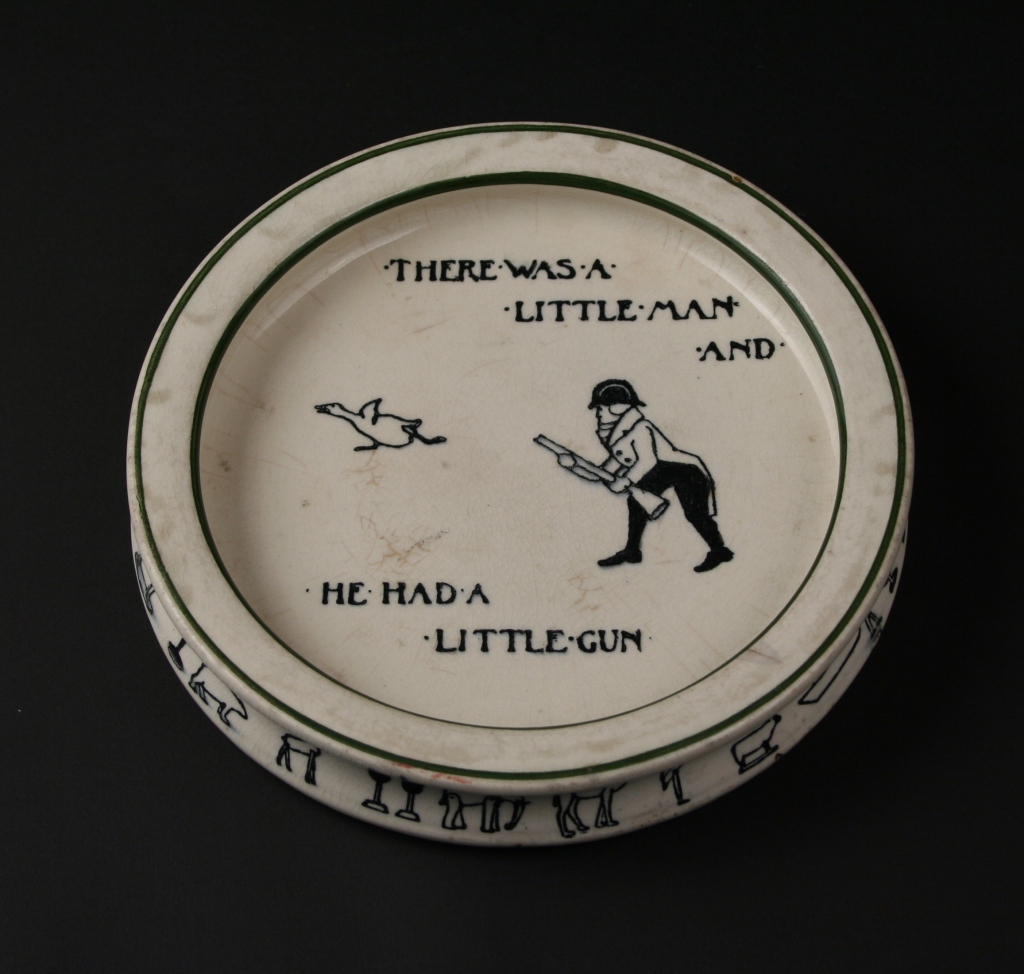

Of course we have Bunnykins and Peter Rabbit, but we also have child’s dishes and utensils with astronaut themes, Howdy Doody, and lunch boxes with Roy Rogers and Dale Evans. And Snoopy. Popular culture dictated what became popular and playful child’s dishes. This is the hard curatorial work someone must do. Taylor Smith & Taylor manufactured the Howdy Doody dish that is illustrated.
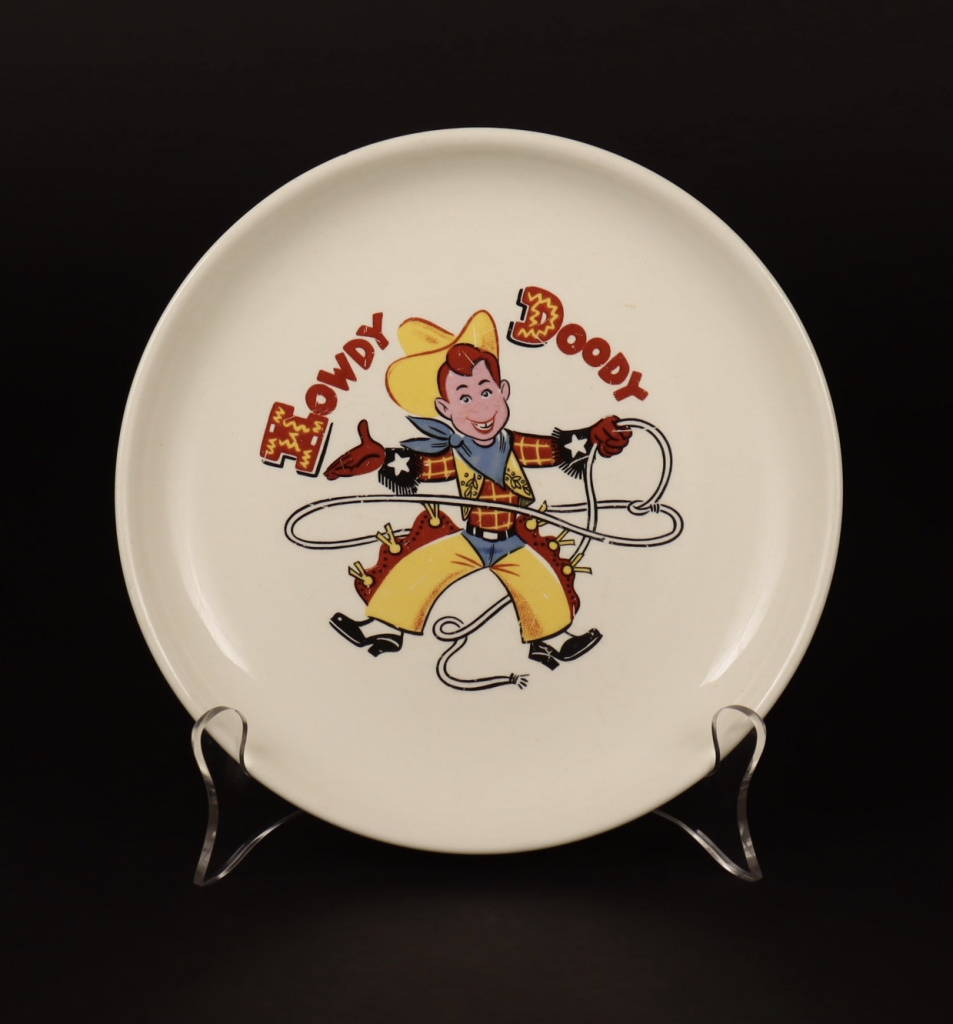
Baby food warmers, many created in pastel glazed ceramic forms of recumbent clowns and Donald Duck by Red Wing for Hankscraft, were to be filled with hot water when their stopper “heads” were removed. More than one young visitor to an IMoDD exhibition has wondered why one needed baby food warmers when the microwave is so handy! When was it that microwaves became common in our kitchens?
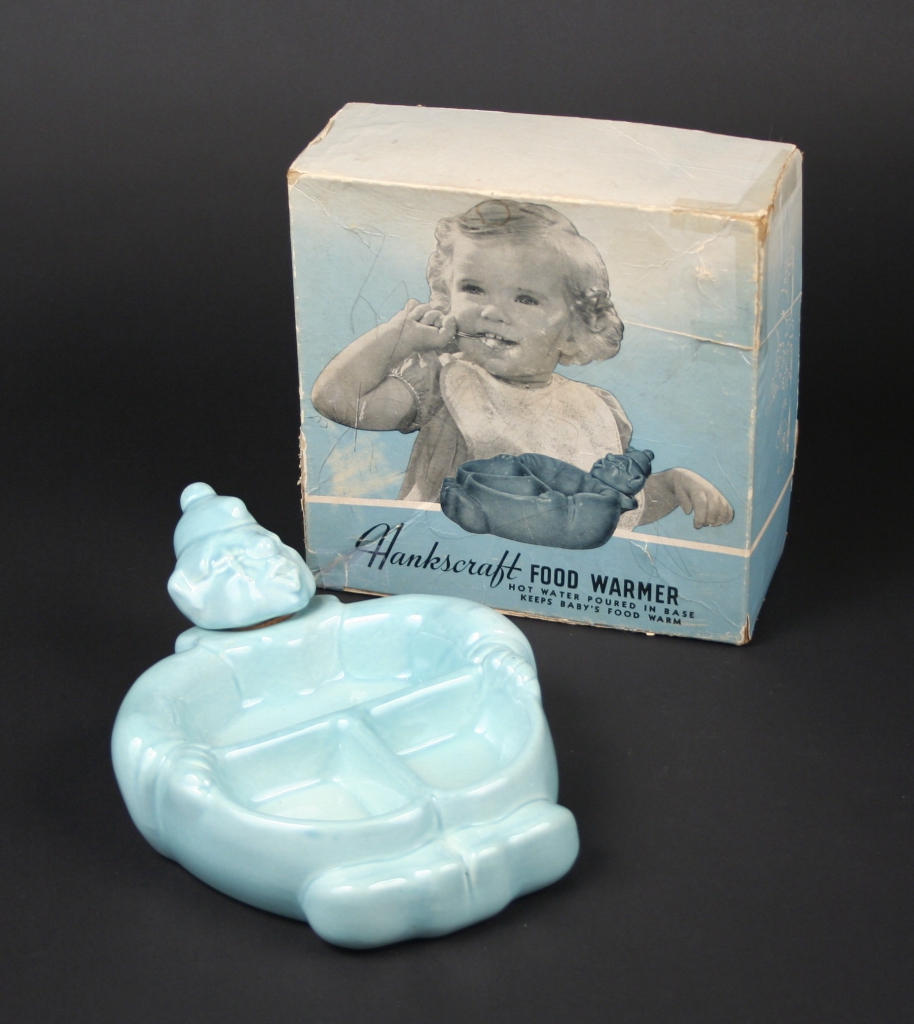
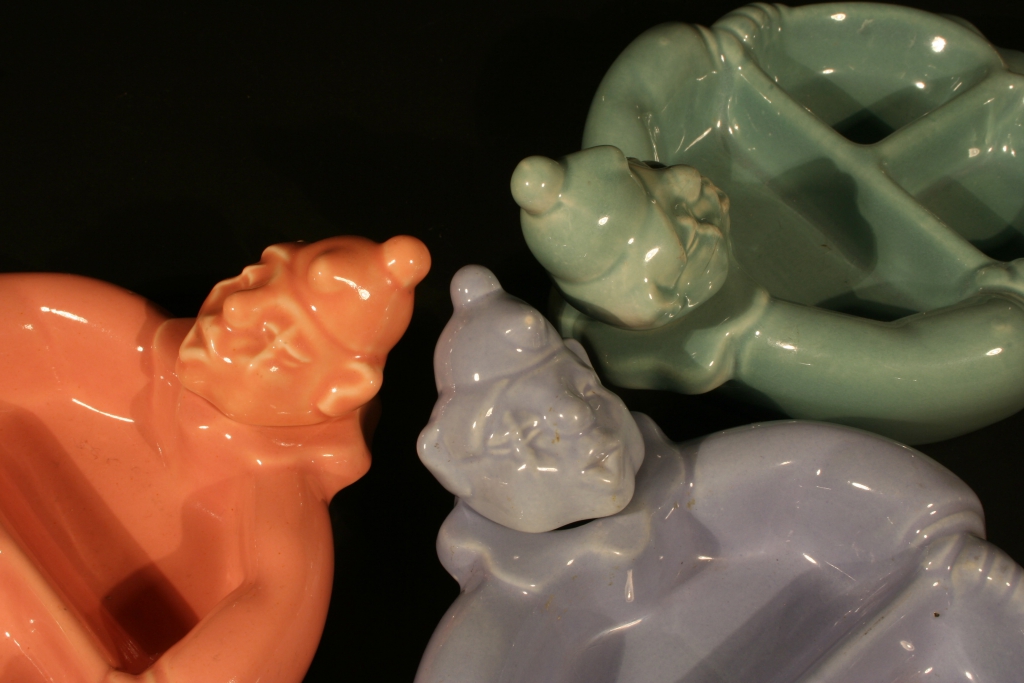
There are many different “flavors” of tin litho play dishes. One favorite in the IMoDD collection comes with its own tin litho display cabinet for the serving pieces, dishes and cutlery. This free- standing tin litho display cabinet in faux “wood” is also equipped to be fastened to the wall. It demonstrates the compatibility of metal and plastic as design materials, and also their popularity.
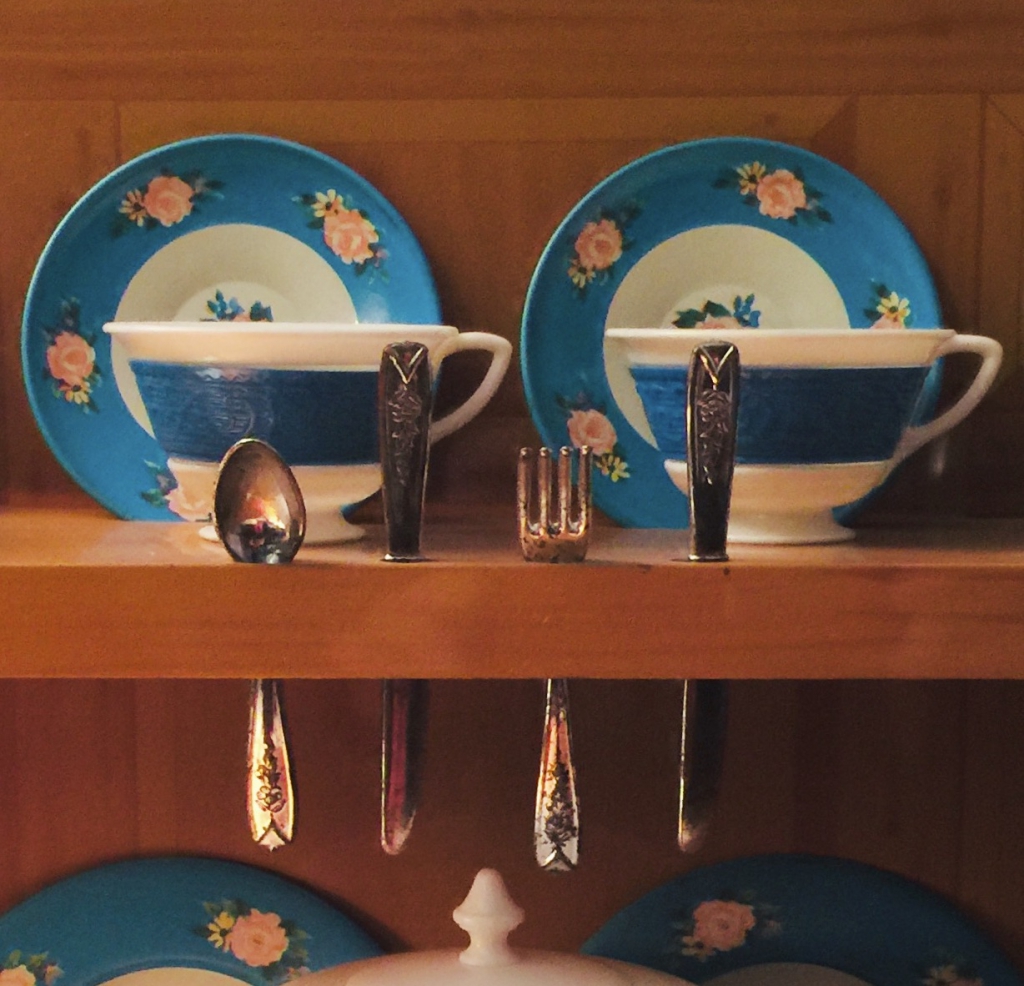
When it comes to playful plastic dining sets for children, there is possibly nothing more fun than the Jack and Jill Chow Chow feeding trains of the 1940s-1950s. Made by B.W. Molded Plastics of Pasadena, California, not only does the original box tell you it will be fun to eat from the Chow Chow train, but that the set includes a divided dish aboard the tender, a fork and spoon set located inside the cab that are shaped like railroad conductors and engineers, and the tumbler is attached to the engine as the smoke stack. AND it came in pink, yellow, red, blue, green, white and clear plastic. Later versions from Tommee Tippee J & J came in orange and turquoise.
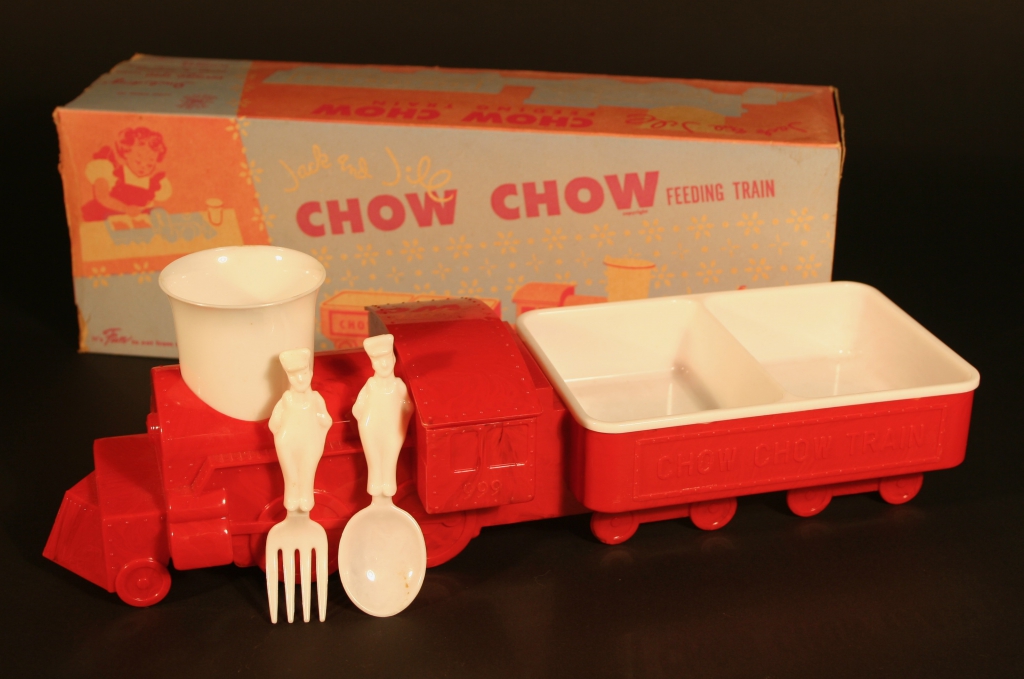
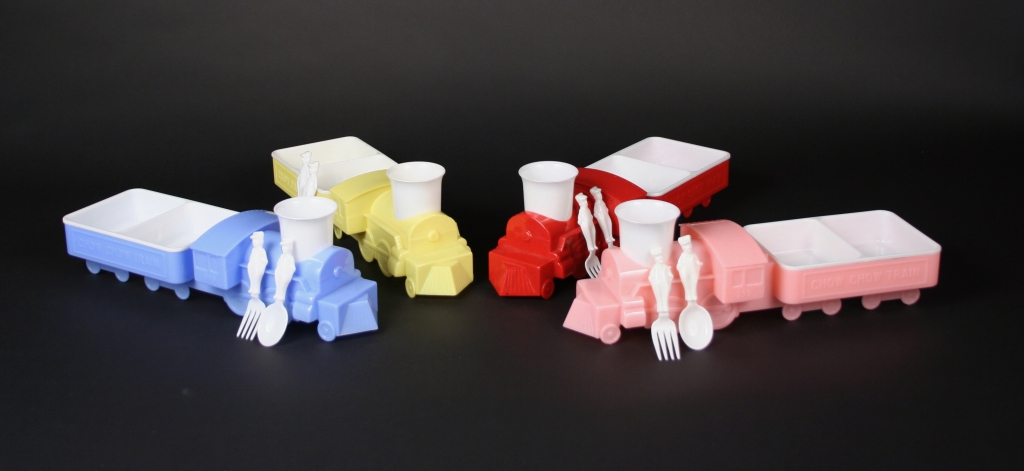
The leading designers and manufacturers of each era created memorable playful dishes for children. Eva Zeisel designed Wee Modern for her daughter Jean. The one example from this set that IMoDD has in its permanent collection was clearly loved and used. Definitely not in mint condition, but it must have been well-loved by its owner.

In the 1940s, Viktor Schreckengost designed several sets of children’s dishes for Salem China, including the Hobby Horse series and Bo-Peep.

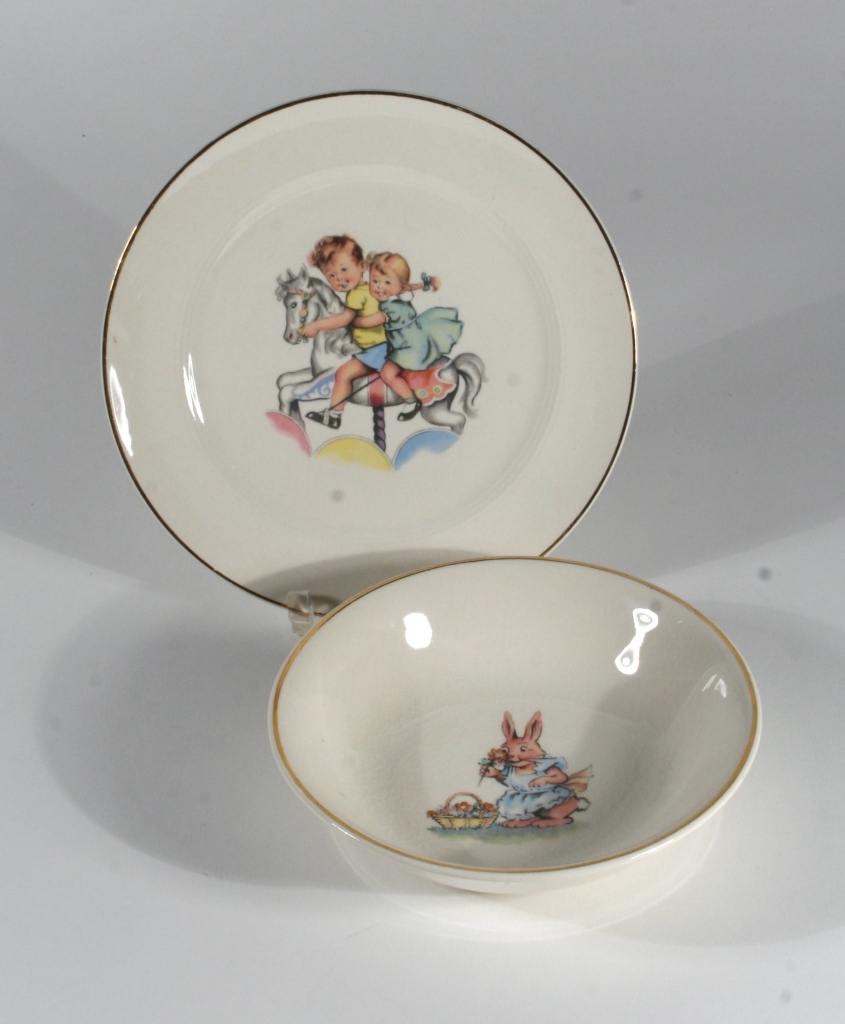
Harker Pottery made charming sets for children as part of their Cameoware line. The motif on the IMoDD collection plate is a goat pull-toy, while a circus elephant adorns the cup.

Of course some playful child’s dishes are stranger than others. From Czechoslovakia in the 1920s, one IMoDD set stands out. It depicts Humpty Dumpty sitting on the wall, cigarette in hand and wearing a monocle and what appears to be fishnet stockings.

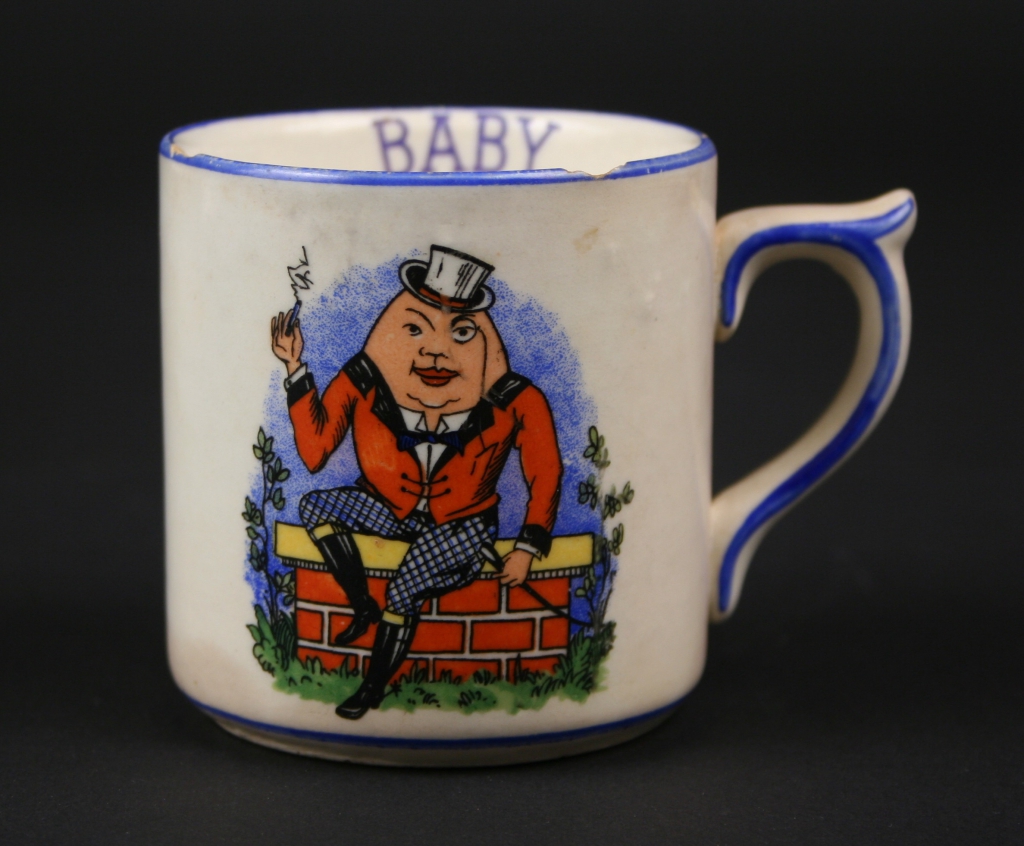
With the current popularity of the wildly successful Barbie movie, IMoDD has no Barbie dolls, but does have a table, chairs and dishware that Barbie and Ken might have selected themselves if they weren’t busy making a movie. It isn’t all pink, so maybe it really wasn’t meant for Barbie.
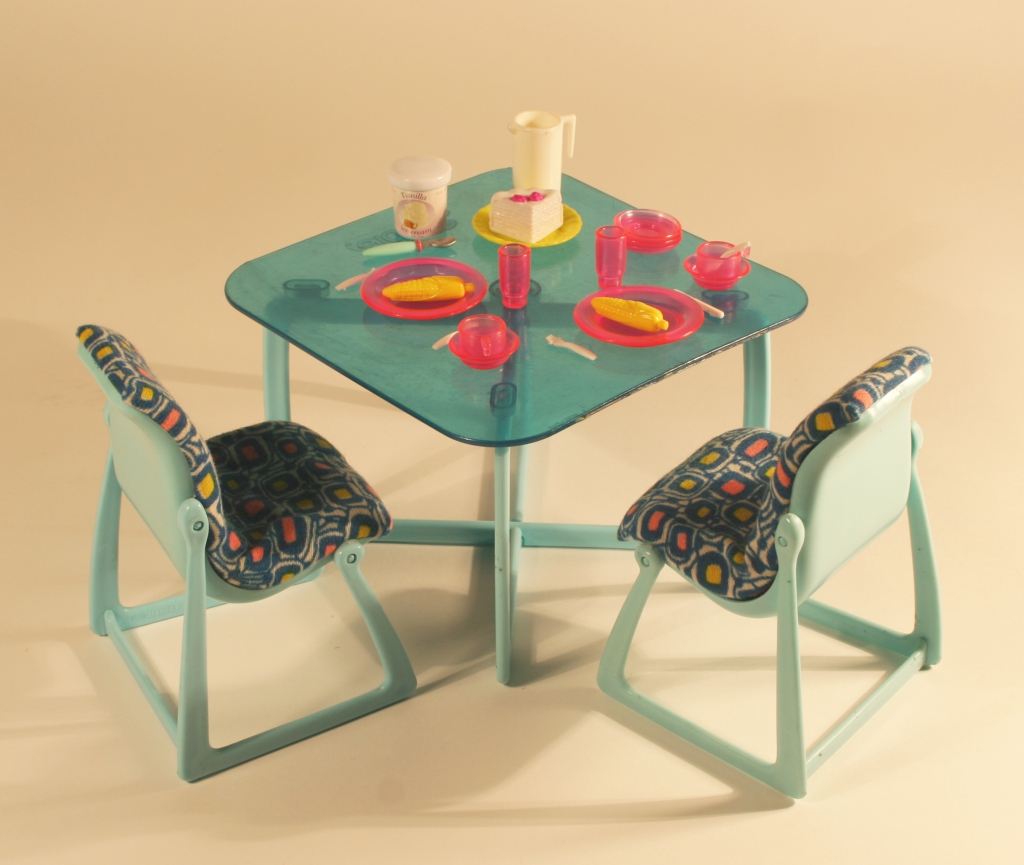
The IMoDD collection also has some child size chairs and tables that children used for their play dining moments. Once again, the linoleum table surfaces and vinyl upholstered seats add authenticity to mimicking the lifestyle of the grownups. Set the table, and playtime begins.
A favorite among the IMoDD collection, is the Marx ranch style home in the IMoDD collection. While we have the furniture for the whole house, our focus always centers on the kitchen.
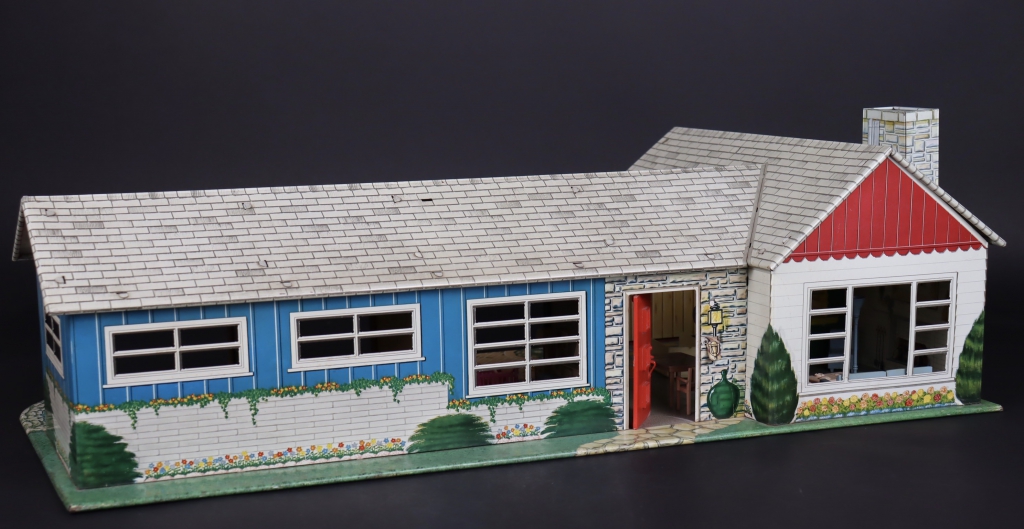
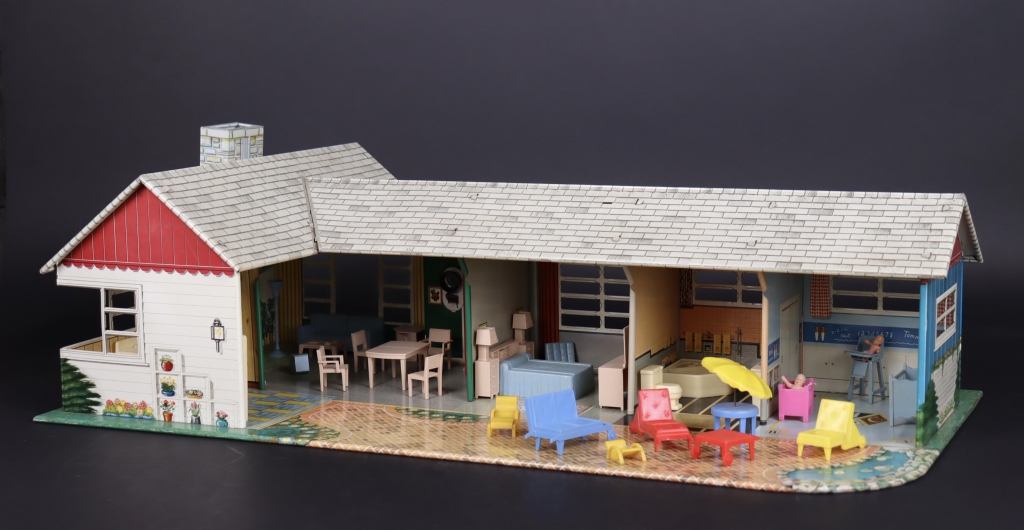
While the IMoDD collection clearly collects and adores playful dishware and has only shared a small portion of its playful dining collection in this virtual exhibition, one final example must be shared. This piece would have delighted toddlers to seniors – the “napkin lady.” She would have been a centerpiece on the table or lived her life to the fullest on the counter in the kitchen. She literally touched everyone’s lives, bringing good etiquette and setting sanitary standards in adoring households from at least the 1940s.

My hope is that this exhibition has caused the visitor/collector to ponder how playfulness and dining intersect. Eva Zeisel has spoken about the “playful search for beauty,” as the first activity for man. Eva believed that “playful” was an important quality of a designer. Her thoughts on this topic were the original inspiration for this exhibition.
Margaret Carney, curator
Catalogue of the Exhibition
Essays by Scott Vermillion
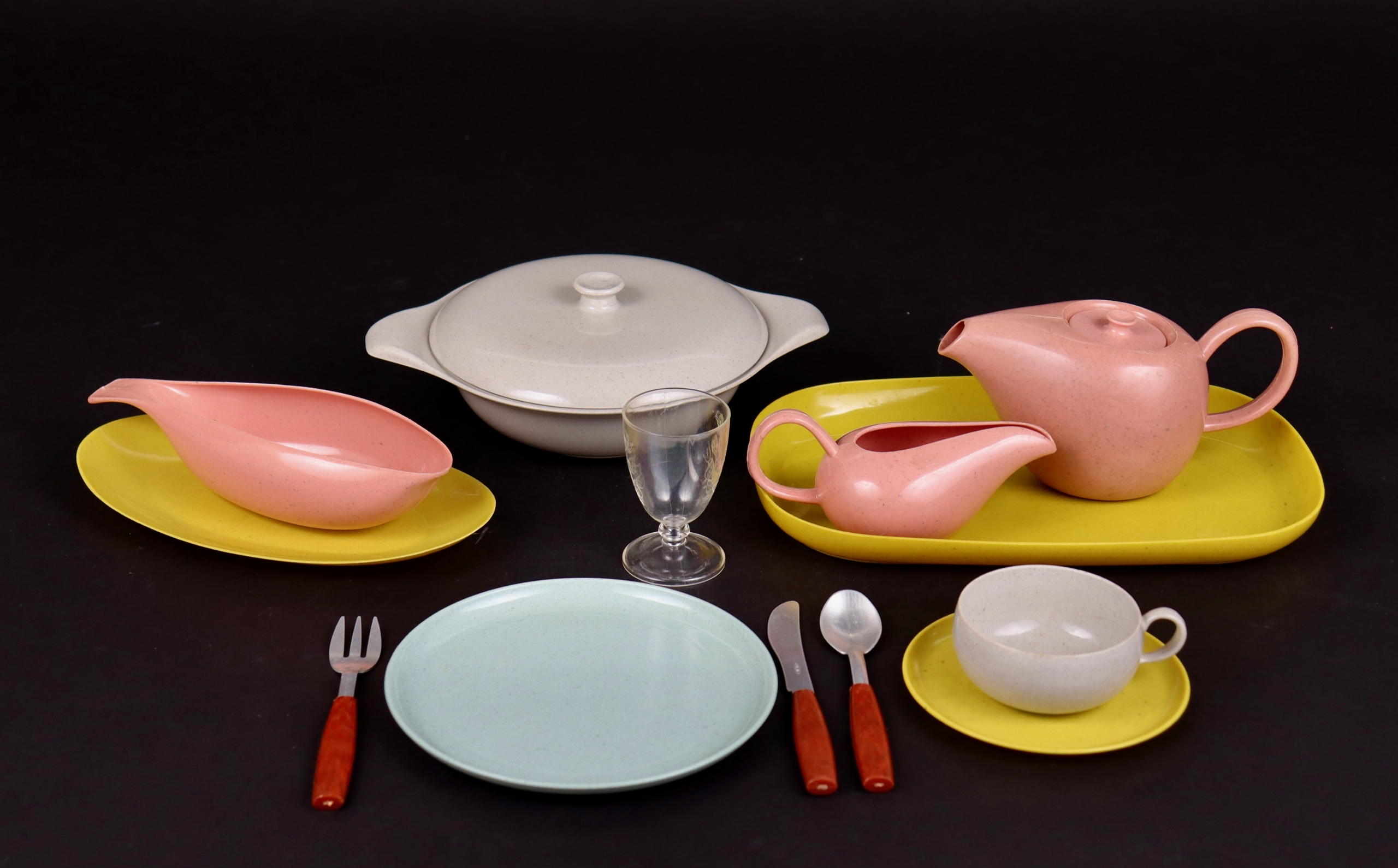
American Modern Play Dishes
“It’s fun to serve your friends in real Russel Wright dishes just like mother’s.” The American Modern Play Dishes were manufactured by the Ideal Toy Corporation, who said, “Make-believe homemakers, Mr. Wright designed this modern dish set just for you!”
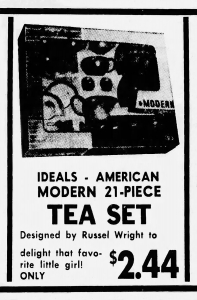

Annie Wright, Russel Wright’s daughter and who was six years old at the time, says that he designed the set with her in mind. It is unclear if Wright contacted Ideal with his idea for an American Modern play dish set, or if Ideal pursued Wright.
Introduced for the 1956 holiday season, the sets were priced from 98-cents to $2.98 and included toy dinnerware pieces that were exact miniatures and very close in color to the actual Steubenville-produced American Modern ceramic dinnerware. Sets included a tea pot, creamer, covered sugar bowl, covered casserole, gravy, gravy underplate, dinner plates, cups, saucers, tumblers, utensils, and napkins. The sets were marketed to children ages 3 to 8 and were made of high-impact plastic. Bigger sets were offered later, with a $4.78 price tag for a 52-piece set in the Sears 1959 Christmas catalog. These later sets were produced in brighter colors—orange, tan, and yellow, unlike the original glaze colors.
In 1956, Russel Wright was considered one of America’s most celebrated industrials designers, known for his innovative dinnerware design, American Modern, introduced in 1939 and produced by the Steubenville Pottery Company in Ohio. Despite initial slow sales, it won the American Designer’s Institute best ceramic dinnerware award in 1941 and was featured in the U.S. Industrial Design 1949-1950 catalog issued by the Society of Industrial Designers for its unique shapes, glazes, and colors. During the 1940s and early 1950s, American Modern became one of the most successful dinnerware lines, and it made Russel Wright a household name in design. It’s no wonder that Wright partnered with Ideal to produce a child’s version of this dinnerware. The Steubenville Pottery Company closed in 1959 due to intense foreign competition. However, Ideal continued to sell the American Modern children’s dinnerware version until the end of 1964.
Ideal Novelty and Toy Company was founded in 1903 when Morris and Rose Michtom of Brooklyn, invented the Teddy bear. Rose had made a bear for their children, and Morris and Rose sent a similar bear to President “Teddy” Roosevelt and obtained permission to use his name for the bear. After Morris died, the name was changed to Ideal Toy Company. Ideal’s best-selling products included Betsy Wetsy, the Shirley Temple doll, games like Mouse Trap, Hands Down, and the Rubik’s Cube. The company ranked among the top three toy companies in the United States by 1971 but was sold several times in the 1980s and ceased to exist after 1997.
After the American Modern Play Dish set was introduced, Russel Wright continued to work with the Ideal Toy Company to develop an adult line of refrigerator storage and dinnerware serving pieces made from Fortiflex, a polyethylene resin plastic developed by the Celanese Corporation. The company formed a new subsidiary, Idealware Inc., and the line was introduced at the January 1958 Chicago Housewares Show. With production delays, Wright’s Idealware was not available for purchase until early 1959. Despite heavy promotion, it failed to resonate with consumers and was quickly discontinued.
References: The Collector’s Encyclopedia of Russel Wright, Ann Kerr, Collector Books, 1998; Woolworth’s Advertisement, Lodi News-Sentinel (California), November 26, 1956; American Modern Package, Etsy, MVSEVMshop; Ideal Toy Corporation, Wikipedia; U.S. Industrial Design 1949-1950, Society of Industrial Design, New York, The Studio Publications Incorporated; Ideal Toy Expands, The Akron Beacon Journal (Ohio), December 15, 1957, Page 51.
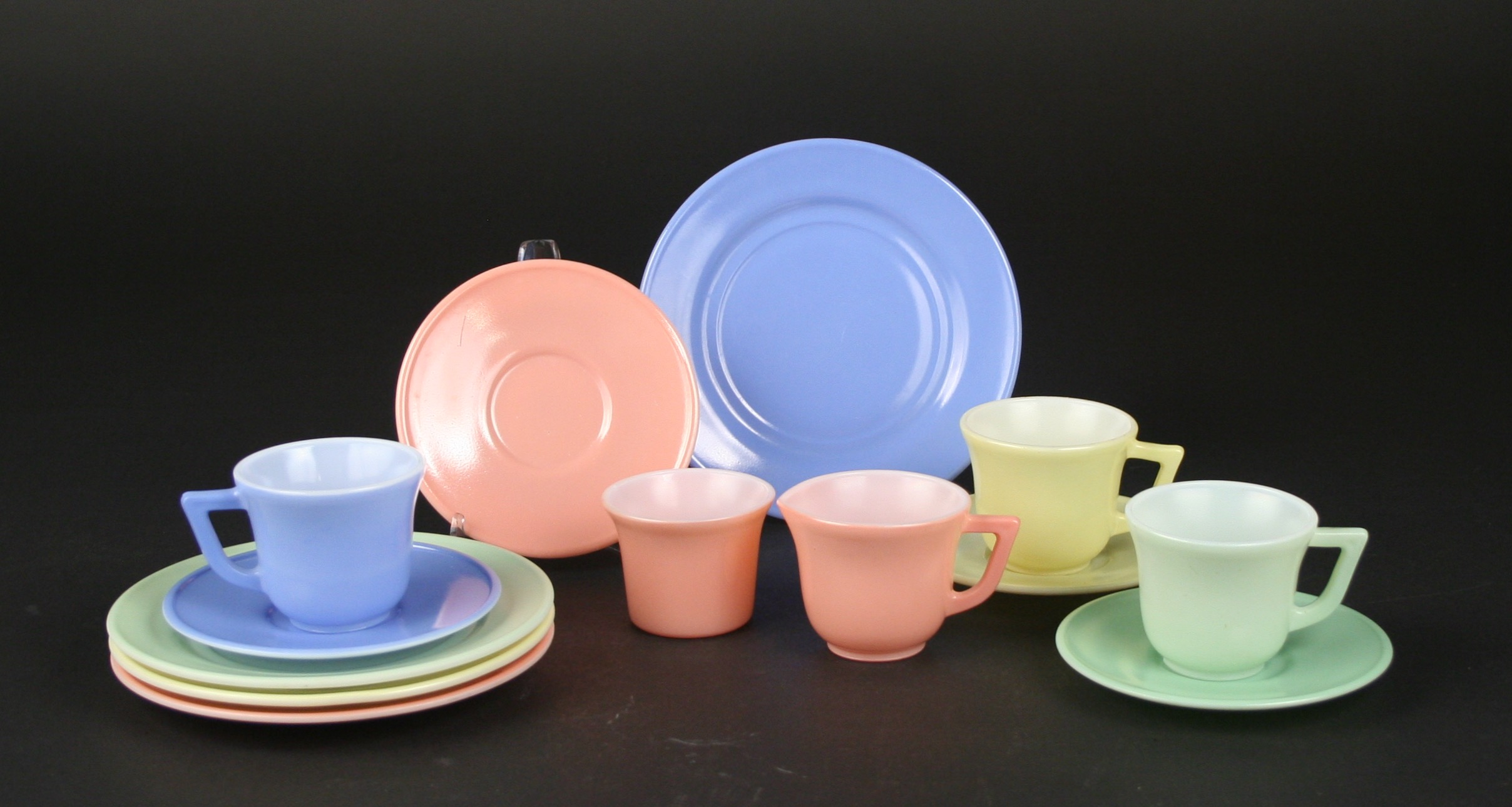
Hazel Atlas The Little Hostess 20th Century Party Set
Just in time for the 1942 holiday selling season, machine-molded glassmaker Hazel-Atlas launched their Little Hostess Party Set described as being “…just like Mother’s” Moderntone dinnerware made from strong, white Plantonite glass, perfect for kitchen use and safe for children’s dishes. Hazel Atlas produced three types of children’s Little Hostess Party Sets: Moderntone with two or three rings on the body, Sierra with two rings, and 20th Century (sometimes called New Century) that resembled the Hazel-Atlas Ovide Plantonite dinnerware with no ring details.
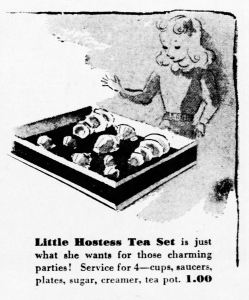
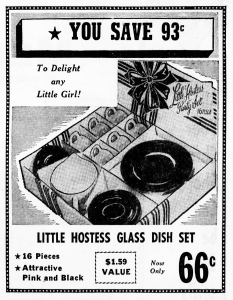
Little Hostess Moderntone sets were produced in pastel pink, blue, green, and yellow. The Sierra sets were available in a large variety of non-pastel colors including green, gray, burgundy, chartreuse, cocoa, turquoise, black, flamingo pink, white, gold and rust. The 20th Century sets produced in pastels, white and in unusual “Fiesta” colors, both on Plantonite and clear glass. Hazel-Atlas ended the Little Hostess Party Set production around 1954, with stock remaining in stores until 1959. The set’s lack of popularity or overproduction might have contributed to the end of production. Although Plantonite glass was durable, safety concerns and competition from plastic and metal toy tea set manufacturers may also have been contributing factors.
In 1952, a 14-piece Little Hostess Sierra Set containing 4 cups, 4 saucers, 4 plates, creamer, and sugar, sold for $1.00 in a bright gift box, in assorted gay colors of chartreuse, gray, green and wine. As inventory decreased after 1954, sets ranged from $1.49 to $1.59, with some sets selling two-for-88-cents on closeout sale.
Hazel-Atlas Glass Company was founded in 1902 as a merger of four glass companies, including the Hazel Company and the Atlas Glass Company which produced glass bottles and packaging. The newly formed company expanded its production to include affordable tableware. To remain competitive during the Depression, Hazel-Atlas continued to enhance its glass production machines and processes, producing large quantities of “Depression” pressed glassware in various patterns, as well as milk glass containers, commercial bottles and jars, and Atlas-branded jars for home canning. In 1957, Hazel-Atlas became a subsidiary of Continental Can Company. In 1964, after the acquisition was challenged in an antitrust lawsuit, Continental sold the Hazel-Atlas production facilities to A. H. Kerr Glass Company and the Brockway Glass Company to settle the lawsuit.
References: Hazel Atlas Glass Child Tea Sets, Hazel Atlas Glass website; Little Hostess Party Sets, January 2014 Newsletter, Hazel Atlas Glass website; Hazel-Atlas Glass Company, Wikipedia; Red Cross Department Store Advertisement, The Miami Herald (Florida), December 5, 1942; Hazel-Atlas Glass History, West Virginia Northern Community College website.
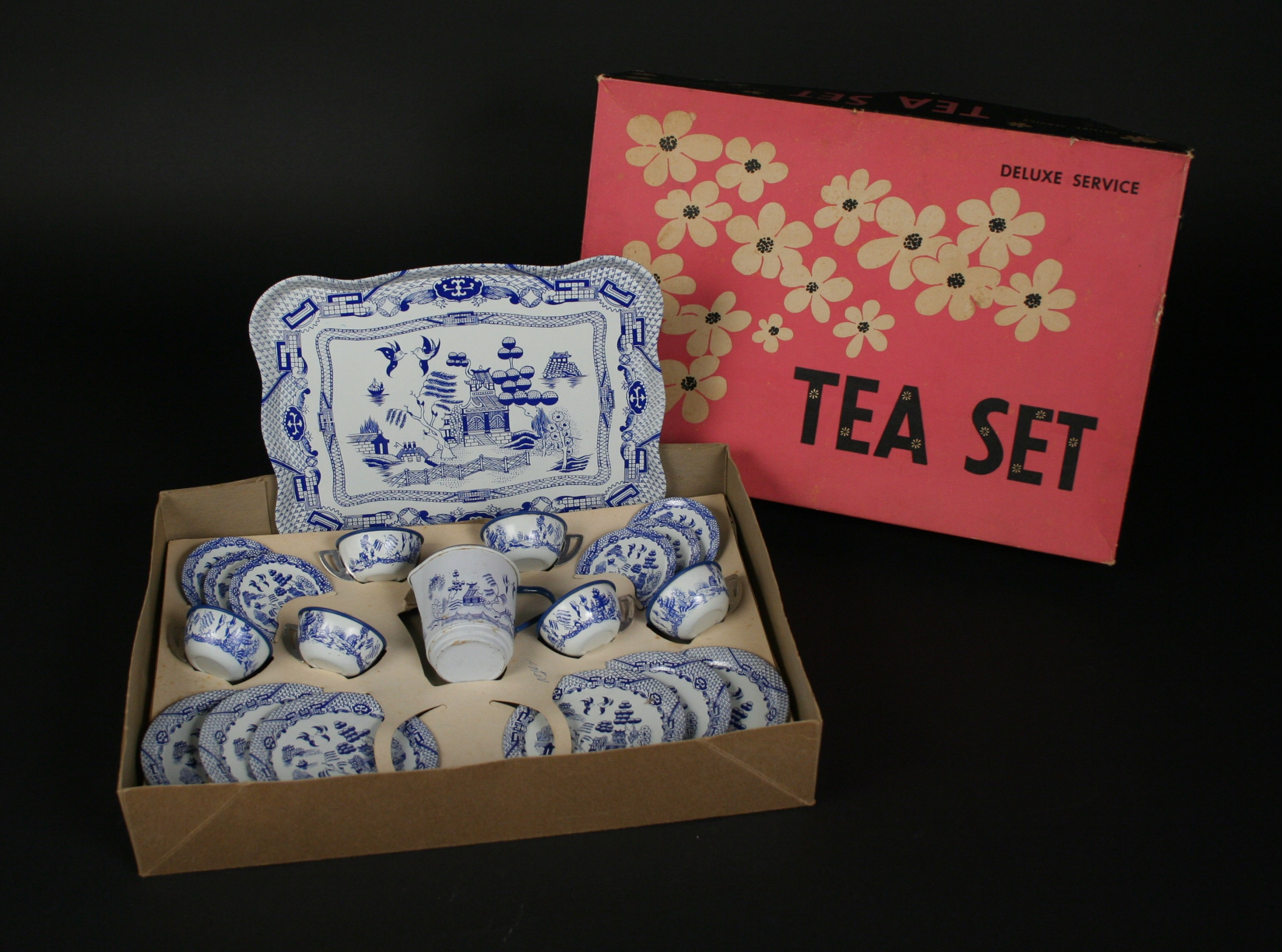
Ohio Art Company Blue Willow Deluxe Service Tea Set
Ohio Art Company introduced its Blue Willow Deluxe Service Tea Set around 1953, building on its long history of producing charming, lithographed metal children’s tea sets. Advertised as a safe, entertaining, and educational toy, the tea set included a serving tray for the little hostess to serve tea in an elegant Blue Willow pattern that resembled mothers. Inspired by hand-painted ceramic wares from Qing dynasty China, Blue Willow dinnerware was created by English ceramic artists. Its elaborate chinoiserie transferware pattern made it sophisticated but inexpensive to produce. Blue Willow was extremely popular at the end of 18th century England and continued to have worldwide popularity when Ohio Art produced its tea set.

In 1953, Ohio Art priced the 21-piece Blue Willow Deluxe Service Tea Set at 98-cents, and continued to sell the set through 1963, and perhaps later.
In 1908, Dr. Henry S. Winzeler, a dentist in Archbold, Ohio, established the Ohio Art Company, driven by his belief in the potential of novelty manufacturing. The name was derived from his love of art, with picture frames as the starting product. After relocating to Bryan, Ohio, and installing metal lithography equipment, the company flourished and set the stage for its future success. When World War I disrupted German toy imports, Dr. Winzeler saw an opportunity, and expanded his toy line, which boosted his business, including the popularity of a high-quality tin tea set for children in 1917. They introduced sand pails in 1923. In the early 1930’s, Ohio Art was one of the very first companies to license a character from Walt Disney for a toy; Steamboat Willie, the precursor to Mickey Mouse. Ohio Art converted to making war products during World War II. After 1945, the company continued to make lithographed metal toys, and began using plastic. In the e1960s, Ohio Art introduced the groundbreaking and wildly popular Etch-A-Sketch. The company still operates as a publicly-held corporation in Bryan, Ohio.
Resources: The Origins of Our Success, Ohio Art website; Story of the Willow Pattern, Amanda Draper, Curator of Arts and Exhibitions in 2021, January 15, 2021, University of Liverpool, vgm.liverpool.ac.uk; Willow pattern, Wikipedia; 21 Piece Tea Set in Box, eBay, cedarlodgetrading; Pringles Self-Service Drugs Advertisement, The Register (Santa Ana, California), December 7, 1953.
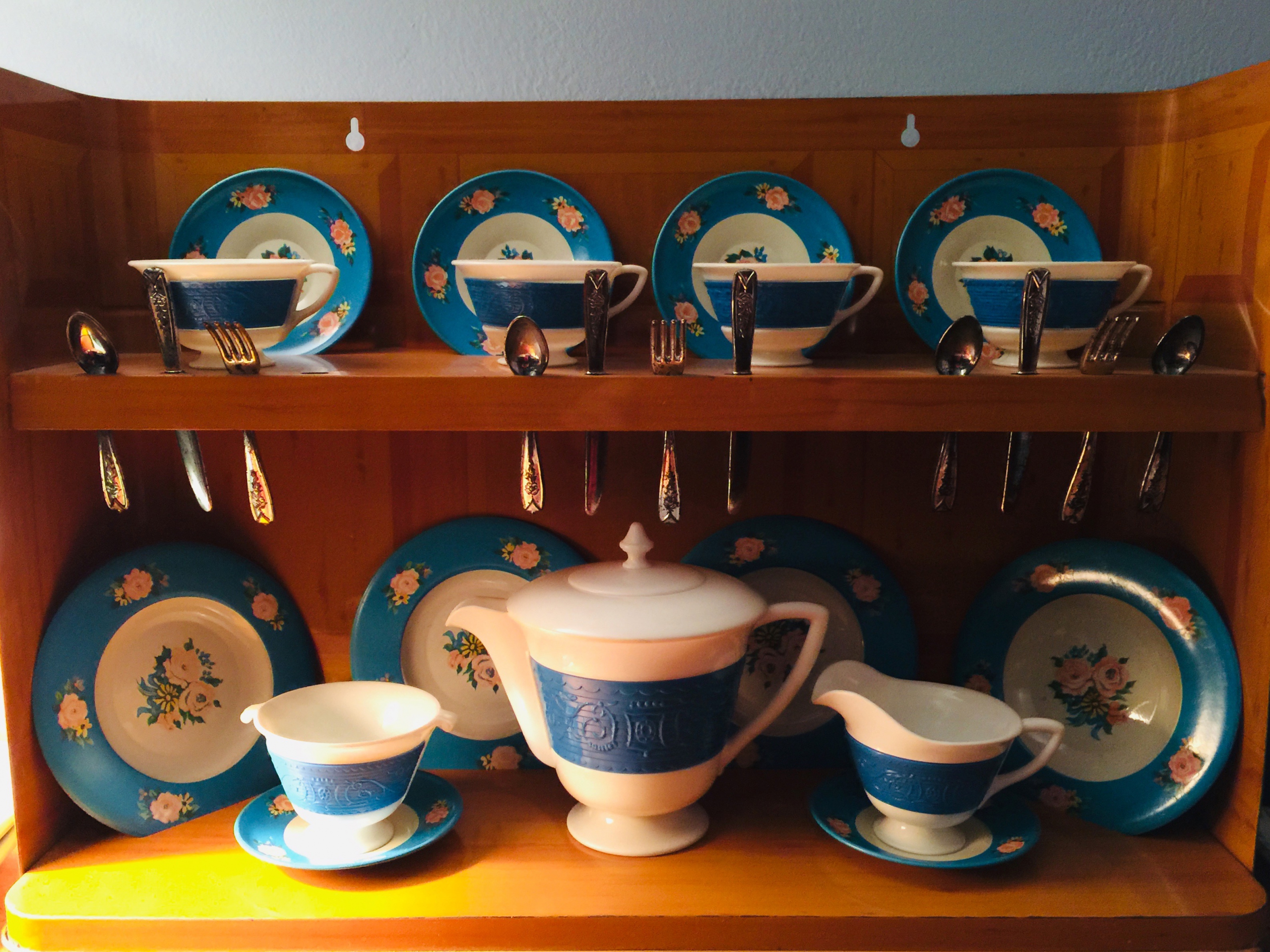
Bannerware Deluxe Refreshment Set

The Bannerware Deluxe Refreshment Set, introduced by Banner Plastic around 1948, featured a plastic tea pot, creamer, sugar, plates, cups, saucers, and utensils, all designed “to charm a little girl.” A lithographed metal cabinet “for the little hostess” helped keep her tea service organized. The set was priced at $1.98.
Emanuel M. Pressner and Bernard Schiller founded Banner Plastic Corporation in either late 1945 or 1946, with their factory situated in the Bronx on Bruckner Boulevard and their showroom located on Fifth Avenue in New York City. Prior to the formation of Banner, Pressner was initially a toy importer, and later worked for Columbia Protektosite, a plastic injection-molding company based in New Jersey that specialized in sunglasses, googles and other plastic products including toys from its subsidiary company Plastic Art Toy Company of America. Banner Plastic moved into a large facility in Paterson, New Jersey planning to employ 350 people. In addition to dish sets, Banner produced plastic and metal toys such as cars, trucks, trains, military vehicles, and inexpensive bagged toy sets. For their metal toys, inexpensive steel came from “off-falls,” the blanks left over when holes are cut into steel sheets. At its peak, Banner produced tens of thousands of toys per week. After filing for bankruptcy in 1965, Banner was purchased by Tal-Cap, a Minnesota toy conglomerate, and should not be confused with Banner Toys, a manufacturer of wooden toys established in 2011.
References: Banner Plastic Corporation History, Worthpoint; Columbia Protektosite Presents Comb Which Stands Up…, The Herald-News (Passaic, New Jersey), November 8, 1946; New Paterson Firm Will Employ 350, The Herald-News (Passiac, New Jersey), May 3, 1950; Buffums’ Toy Sale Advertisement, The Register (Santa Ana, California, April 20, 1955; Banner Plastic Toys Catalog 1950-1951, Banner Plastics Corp. Bill Hanlon Enterprises.
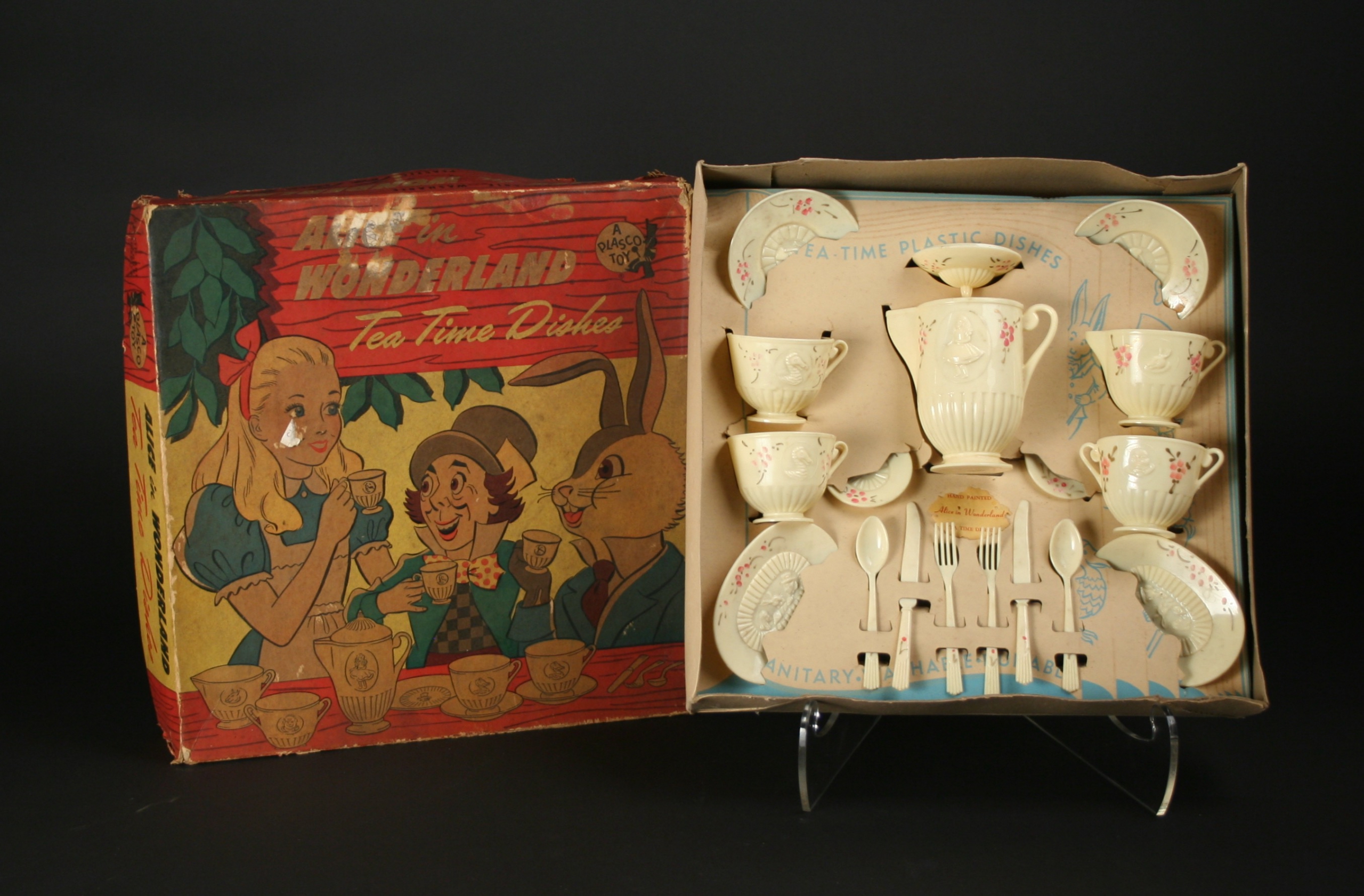
Plasco Alice in Wonderland Tea-Time Dishes
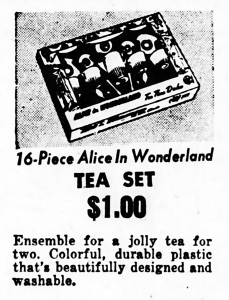
Inspired by the Mad Hatter’s tea party in Lewis Carroll’s Alice’s Adventures in Wonderland, Plasco’s Alice in Wonderland Tea-Time Set was described as “a little girl’s dream come true!” and “cleverly designed plastic dishes that will delight the tiny hostess.” Plasco introduced the Alice in Wonderland Tea-Time Set around 1948, with prices ranging from 48-cents to $2.98 depending on the size of the set. The set featured Alice in Wonderland characters molded in relief on each “pink pearl” plastic piece, which were promoted as sanitary, durable, washable, and outstanding for make believe entertaining. These charming Alice in Wonderland Tea-Time sets were sold in various assortments through the 1958 holiday season and possibly beyond.
Plastic Art Toy Corporation of America, also known as Plasco, was originally located in East Rutherford, and later moved to Paterson, New Jersey. They were known for their realistic dollhouse furnishings, tea-time dishes, space guns and goggles, phonographs, Blinky owl banks, and other “Masterpieces in Plastic.” Plasco was considered one of the leading toy manufacturers in the United States, and was a subsidiary of Columbia Protektosite Company of Carlstadt, New Jersey until it was sold in 1952.
References: Vintage plastic playtime dishes party on, Alyce Hand Benham, Press of Atlantic City (New Jersey), September 10, 2004; 22-pc. Alice in Wonderland Dish Set, Wilkes-Barre Times Leader, the Evening News, November 19, 1948, page 24; Allen’s Advertisement, The Wichita Eagle (Kansas), December 7, 1948; Meyer’s Advertisement, Palladium-Item and Sun Telegram (Richmond, Indiana), November 17, 1950; Alice in Wonderland Tea-Time Dishes with Packaging; ToydeJour, eBay; Little Homemaker, Plasco Advertisement, Columbia Protekosite Co. Makes Hit with New “Flexfit”, Weekly Business Review, The Herald News (New Jersey), June 8, 1950, page 22; Last Year You Had the Drop on Us!, Playthings Magazine, March, 1953; Alice’s Adventures in Wonderland, Wikipedia; 1948 Plasco Catalog, eBay, Geraldinestoys.
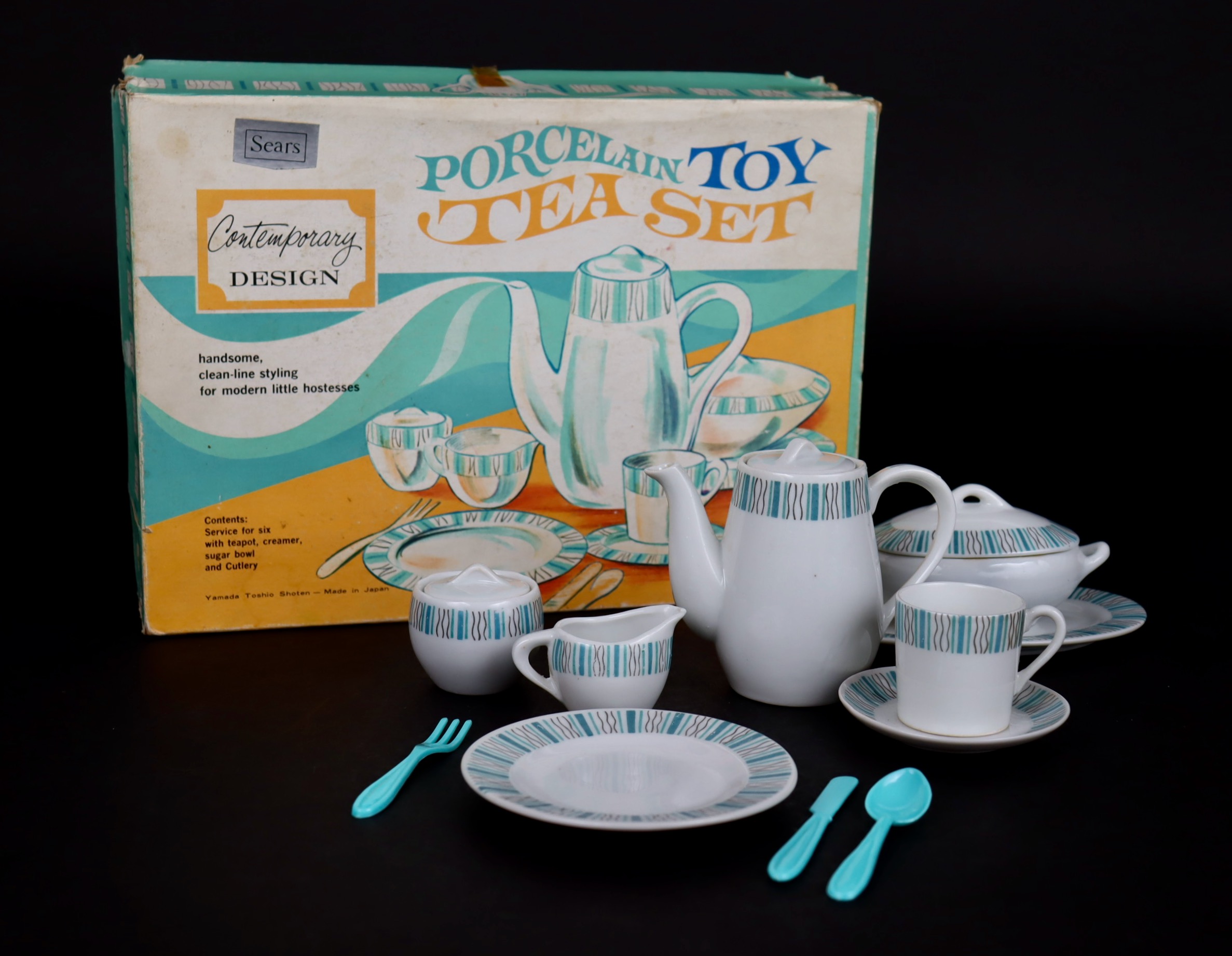
Yamada Toshio Shoten, Japan—Porcelain Tea Set

With a pattern design inspired by the popular Sears Harmony House Scandia dinnerware line (made in Japan), this children’s porcelain tea set was introduced in 1970 and sold at Sears and other department stores nationwide. This sophisticated set included a teapot, creamer, sugar, casserole, plates, cups, saucers, and plastic cutlery. One department store advertisement described the set as having an “attractive pattern in a contemporary mood.” It was priced at $3.19. It was priced at $3.19.
Yamada Toshio Shoten Company, established in 1969 as a decorative ceramics manufacturer in Nagoya, Japan, is still in business and has manufacturing facilities in Vietnam.
References: Scranton Dry—Toyland Advertisement, The Times-Tribune (Scranton, Pennsylvania), December 11, 1970; Kompass, Yamada Toshio Shoten, au.kompass.com.
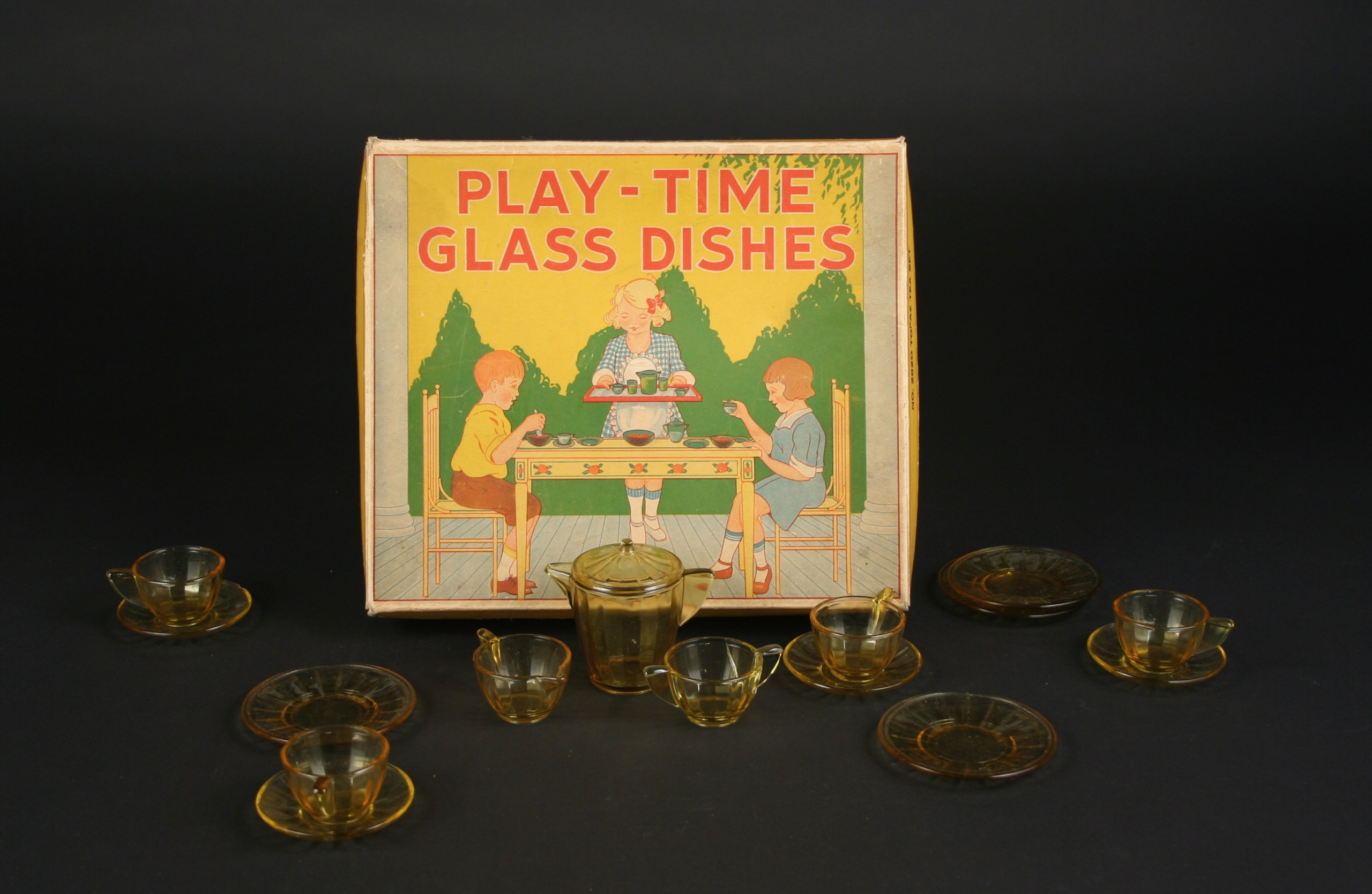
Akro Agate Play-Time Glass Dishes

In 1910, Dr. George T. Rankin, Gilbert C. Marsh (owner of Wagner Marsh Shoe Store), and Horace C. Hill (a former employee of Navarre Marbles) founded the Akro Agate Company in Akron, Ohio. They conceived of the idea of boxing marbles from the M. F. Christensen & Son Company and selling them at Marsh’s shoe store on Akron’s main street. Following their success selling the marbles, they built their own marble-making machinery and installed it upstairs over the shoe store. In 1911, they applied for and were granted the “Akro Agate” trademark. The company relocated to Clarksburg in 1914 due to the abundant availability of natural gas and glass in West Virginia and remained there until its closure in 1951. Throughout most of its history, Akro Agate was the leading manufacturer of marbles in the United States, thanks to its innovative design and manufacturing improvements. Following the loss of two significant marble patent lawsuits in the early 1930s, Akro Agate opted to manufacture other items in addition to marbles, including glass flowerpots, planters, vases, and ashtrays.
Around 1938, they introduced their Play-Time children’s glass dishes, repurposing molds purchased from Westite Glass Company, whose Weston, West Virginia factory had burned in 1936. The dish sets came in mixed colors and a Sears Roebuck advertisement from December showed a Play-Time set priced at 38-cents. With the start of World War II, the United States banned Japanese imports, leading to Akro Agate’s children’s glass dishes finding great success. Akro Agate’s glass dish sets faced serious competition from cheaper plastic and metal sets after the war, leading to a plunge in sales. Despite continued marble manufacturing success, including producing one million marbles daily, Akro Agate stopped production in 1949 and sold their facilities and equipment at auction in 1951.
References: Akro Agate Company, Marble Collectors Society of America; AkroAgate.com; M. F. Christensen & Son Company (1903 -1917), Marble Alan’s Marble Identification Guide; Sears Roebuck and Co. Advertisement, Shawnee News Star (Oklahoma), December 16, 1938; Marble Manufacturer Makes A Million Agates Per Day, Sand Springs Leader (Tulsa, Oklahoma), Page 5, July 28, 1949.

Sandra Lee Cook ‘n Serve Set by Andy Gard Suburban Toys


Inspired by the hugely popular Corning Ware and Pyrex serving ware, Andy Gard introduced the Sandra Lee Cook ‘n Serve children’s tea and cookware sets during the 1964 holiday season. The sets were promoted as “… cookware like Mothers. Simulated glass type casseroles, frypan, coffee pot and warmer will delight any young housekeeper.” Made of break-resistant styrene, and decorated in blue and green, there were five sets available with a variety of plates, cups/saucers, creamer, sugar, glassware, cutlery, frypans, casseroles, and warming stands.
The Andy Gard Toy Company was founded in 1950 by brothers Andrew, Vincent and Samuel Giardina of Pittsburg, Pennsylvania. The company manufactured plastic toys and household goods including remote-controlled cars, dolls, toy soldiers, plastic baseball bats and balls. In the 1965 Andy Gard Suburban Toys catalog, they described their products as being “created and designed by professionals.” Andy Gard’s toys were well-received, so company expanded and moved to Leetsdale, Pennsylvania. In 1963, a fire forced them to move to Oakmont, Pennsylvania, and later operate a plant in Shelby North Carolina. Unfortunately, another fire in 1967 destroyed their Oakmont facility, leading to receivership in February 1967. In 1971, Andy Gard merged with Meridian Industries of Southfield, Michigan, and the brand was discontinued. Meridian Industries operates today, specializing in medical tubing, luxury upholstery fabrics, household and personal care products, and novelty yarns.
Resources: 1965 Andy Gard Suburban Toys catalog; Remote Control Success, Leonard Thompson, December 23, 1956, The Pittsburg Press; The Andy Gard Fire, Gary Rogers, January 13, 2021, Oakmont Historical Society Facebook Page; About Meridian Industries, Majilite website.

Plastic Gun Cups by E-Z-POR Corporation, Chicago
Howdy pardner! Roy Rogers, Gene Autry, Hopalong Cassidy, Red Ryder, the Lone Ranger, and the Cisco Kid were at the height of popularity when E-Z-POR produced these brightly colored plastic, pistol-handled drinking cups. Detailed in molded relief with an ammo belt and Western branding symbols, these plastic cups were perfect for any junior cowboy or cowgirl.
Ben and Lillyann Sarnoff transformed a small innovation, a bottlecap that eased liquid pouring, into a multimillion-dollar housewares empire. Other inventions followed including the disposable E-Z Foil cooking tray, used by many during Thanksgiving. Alongside foil accessories, their products included decanters, refrigerator bottles, drink sets, and the plastic gun cups. By the time they sold their company in 1979, they had obtained 26 patents, and turned their kitchen items into the world’s largest foil ware product company. E-Z-Por Corporation was later sold to Ecko Group of American Home Products, then to Tenneco in 1986, and now Reynolds Consumer Products owns the subsidiary company, E-Z-Foil, operating in Wheeling, Illinois.
Resources: Reynolds Consumer Products, Reynolds Consumer Products website; Office buildings pan out for the tin foil king, Steve Kerch, Chicago Tribune, October 22, 1989; A story in the Real Estate section…, Chicago Tribune, August 10, 2021; Ben Sarnoff Obituary, Chicago Tribune, November 25, 1996, Update August 11, 2021.
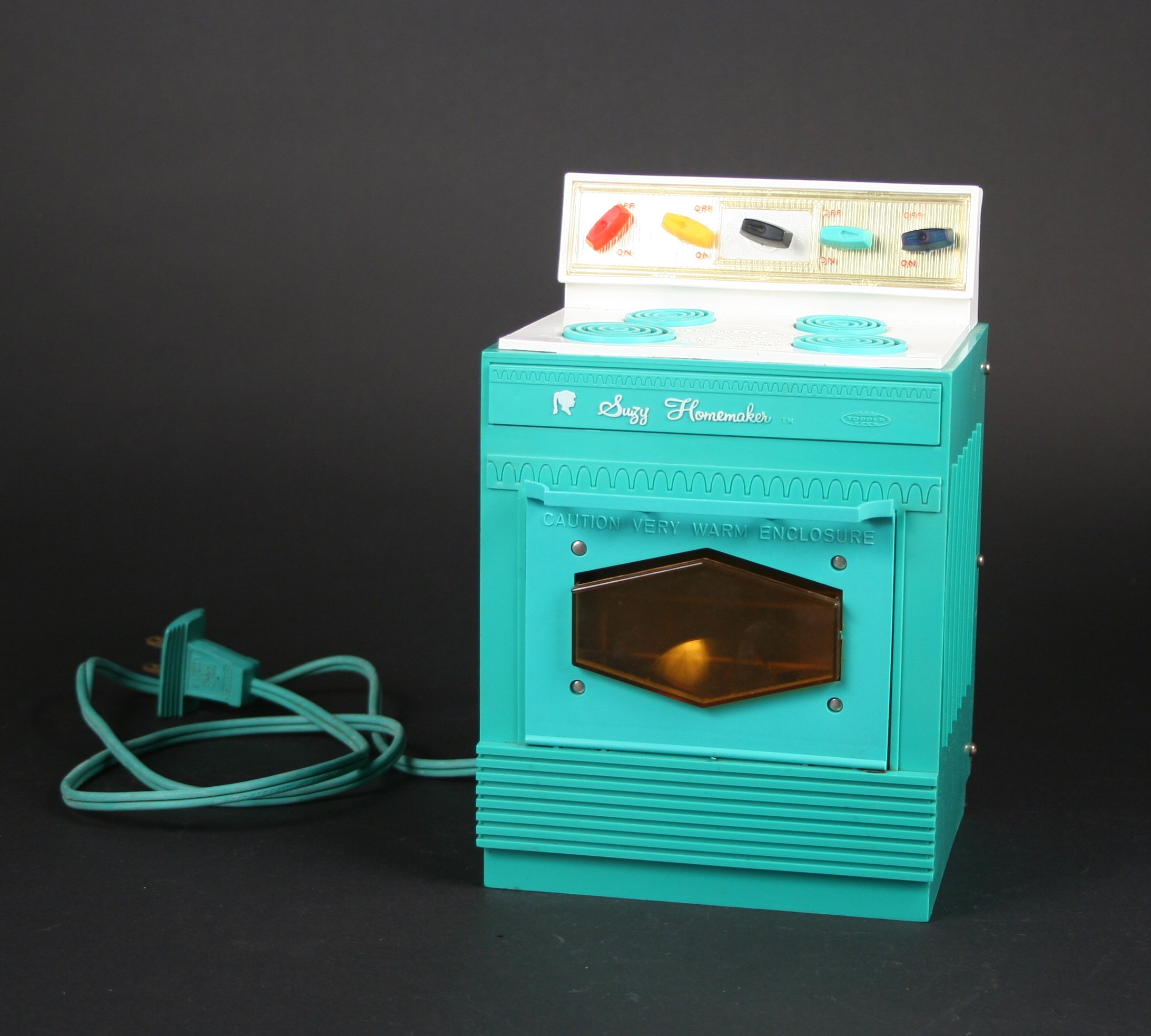
Topper Corporation—Suzy Homemaker Oven
“With Suzy Homemaker, you are the queen of your home!” as proclaimed in a 1967 television commercial. Even if you’re not familiar with these Topper Toys, “Suzy Homemaker” has become a common phrase. “Suzy Homemaker appliances—they really work!”—and with the oven you could bake with mother’s mixes—BIG cakes for a party of 6. It had working burners that could really heat (with a light bulb). All for the “world of busy girls—the world of Suzy Homemaker!”

In 1966, Topper Toys introduced the Suzy Homemaker line of miniature functional household appliances for children included: an oven, blender, grill, dishwasher-sink, refrigerator, ice cream maker, and many other products. Department stores advertised the oven at for as low as $9.88. During Christmas 1966, Tammy Hutchinson wrote to The Cyclone Siren in Iowa’s The Pomeroy Herald, “Dear Santa: I saw you on TV. You looked nice, too. Please bring me a Suzie (sic) Homemaker Oven, a Vacuum Sweeper, and a Marry Poppins doll. Don’t forget some candy.” The Suzy Homemaker toy line became extremely popular, reaching iconic status, but later in the 1970s, but the name was later used by feminists to mock women who were considered too domestic and conservative.
Suzy Homemaker toys were made by Topper Corporation, a board game and toy manufacturer based in Elizabeth, New Jersey. The company, founded in 1951 by Henry Orenstein, a Holocaust survivor, made other Topper Toys with the brand names Johnny Lightning, Johnny Seven O.M.A., and Dawn Dolls. They were the first company to manufacture licensed Sesame Street dolls. After a failed attempt to take the company public in 1971, the company went into bankruptcy in 1973.
References: Suzie Homemaker, Wikipedia; Topper Corporation, Wikipedia; The Cyclone Siren, The Pomeroy Herald (Pomeroy, Iowa), December 22, 1966; 1967 Suzy Homemaker Toys Commercial, You Tube, traci0dee; Susie (sic) Homemaker Commercial, You Tube, tvdays.
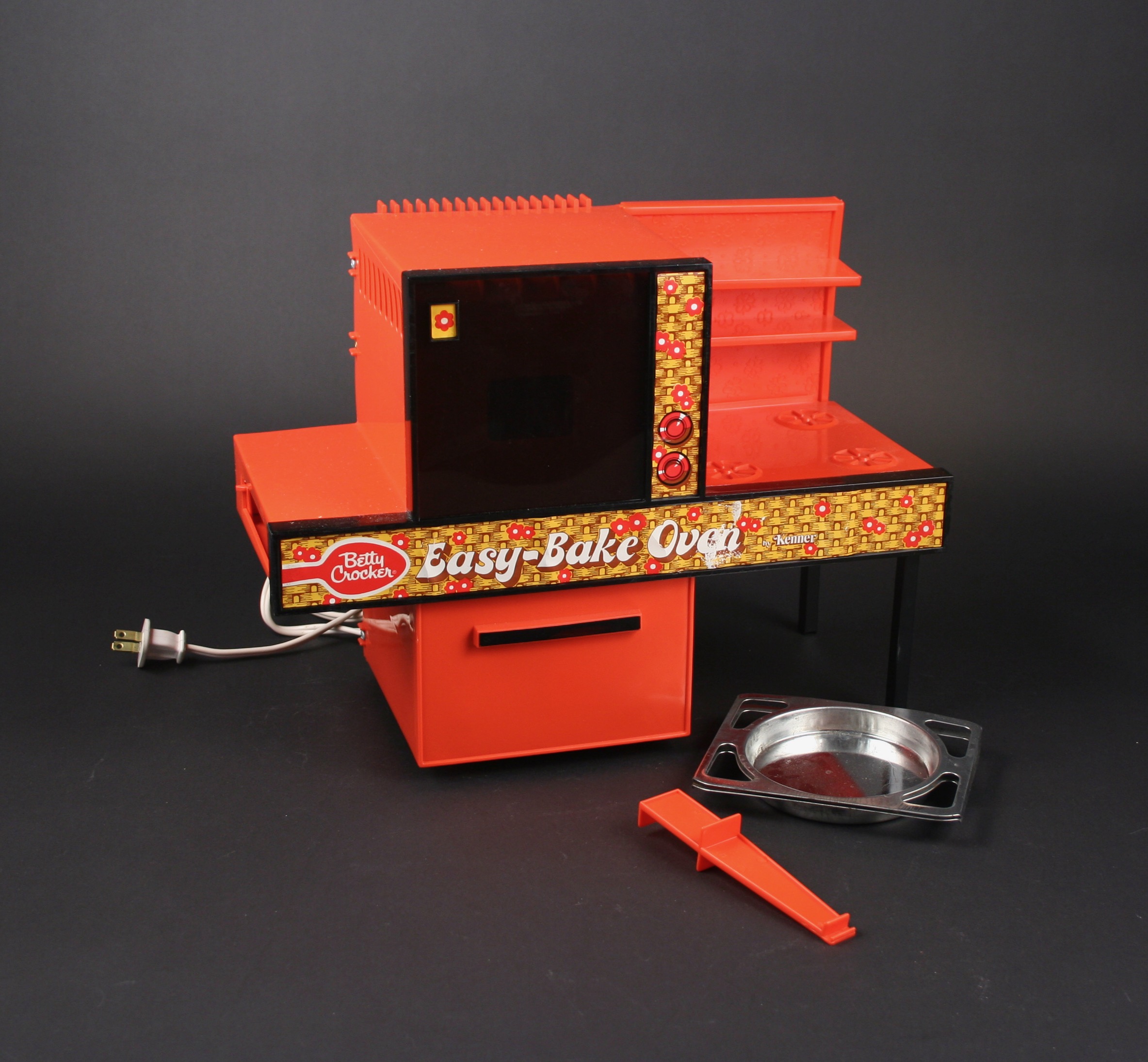
Kenner Products—Easy Bake Oven
“It’s Kenner—It’s Fun! Easy Bake, Easy Bake, fast as you can! Mix ‘em up, mix ‘em up, pour ‘em in the pan! Slide ‘em in, slide ‘em in, let ‘em bake now! Slide ‘em in, slide ‘em out, Easy Bake, WOW! Only Kenner’s Easy Bake Oven makes such delicious cakes, cookies, candy, brownies, pizza, pies, and biscuits. It bakes like magic with two ordinary light bulbs and has a special cooling chamber.” With that catchy television commercial jingle, Kenner introduced its Easy-Bake Oven on November 4, 1963, just in time for the holiday season. It was available in teal or a pale-yellow plastic, it was immediately popular selling 500,000 units in its first year at $15.95.
During the 1960s, many girls penned letters to Santa Claus eagerly requesting an Easy-Bake Oven. In 1967, a typical letter printed in The Tipton Times, Missouri read: “Dear Santa: I tried to be a good girl. Please bring me an easy bake oven and a bike. Bring my brothers and sisters something. Love, Jacqueline Williams”
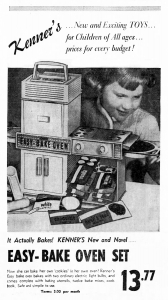
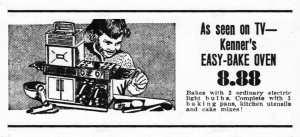
Norman Shapiro, Kenner’s New York sales manager, inspired by ovens used by street vendors to bake pretzels, came up with the idea for the Easy-Bake. The ovens come with small round pans and packets of cake mix, are sold separately. After adding water to the pan, it is pushed into the oven through a slot, where it bakes using two 100-watt incandescent light bulbs. After baking, the cake or treats are pushed out through the slot on the other end of the oven. Later models used one light bulb and relied on convection through better interior heating dynamics.
Kenner was founded in 1946 by brothers Albert and Joseph Steiner and named after the street where its original corporate offices were in Cincinnati, Ohio. General Mills purchased Kenner in 1967 and began including Betty Crocker branded mixes for use in the Easy Bake Oven. Models released in 1969 came with a Betty Crocker cookbook as well. Tonka acquired Kenner in 1987, and was later purchased by Hasbro in 1991, ending a 20-year co-branding partnership between Kenner and General Mills.
The Easy Bake Oven has evolved over the years to mirror actual ovens. In the 1970s, it had wood-grained paneling and an avocado green color, while in the 1980s, a microwave style oven was introduced. The marketing shifted to gender-neutral in 2012, and today’s oven has a streamlined, bean-shaped styling reminiscent of a small toaster or pizza oven. November 4 marks the annual celebration of National Easy-Bake Oven Day, which was inducted into the National Toy Hall of Fame in 2006.
References: Easy Bake Oven Commercial 1963, You Tube, lightbulbbaking, The Untold Truth of the Easy Bake Oven, You Tube, Mashed; Easy-Bake Oven Wikipedia; Kenner Products, Wikipedia; FIRST GRADERS Write Letters to SANTA CLAUS, The Tipton Times (Tipton, Missouri), December 15, 1967, Page 6
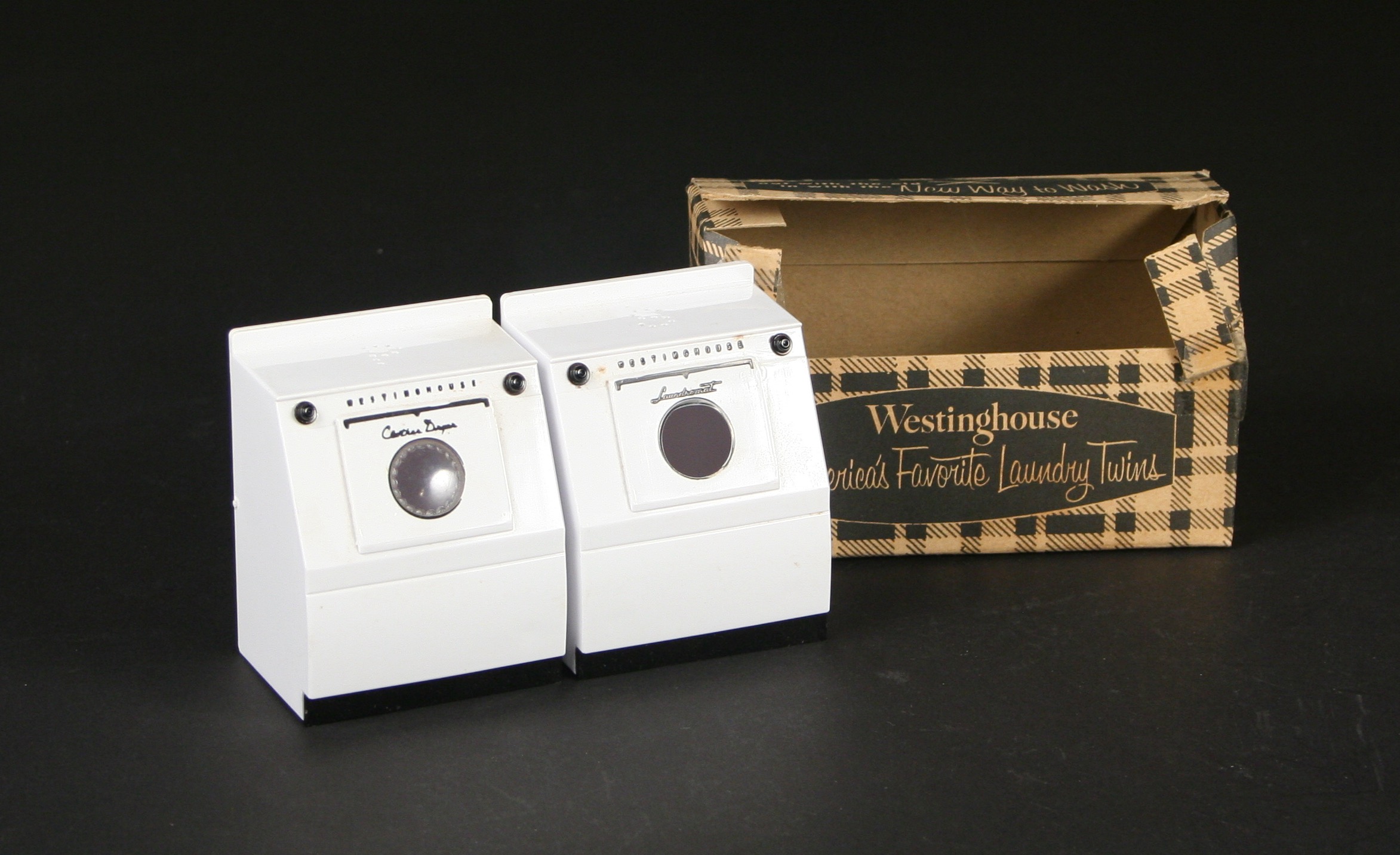
Westinghouse “Twins” Washer and Dryer Salt and Pepper Shaker Set
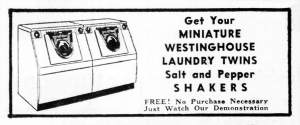
In 1952, Westinghouse promoted their innovative “Laundromat” Washer and Clothes Dryer, Westinghouse by offering a free “Twins” salt and pepper shaker set to prospective customers who attended a demonstration. The campaign’s slogan was “Westinghouse Laundry Twins go together like Salt and Pepper!” The Westinghouse “Laundromat” Washer featured an exclusive “weigh-to-save door and water saver” conserved soap and hot water. The Westinghouse Clothes Dryer dried every kind of clothes just right and “crooned a tune” when the clothes were dry. In a nationwide promotion called “Westinghouse Twins,” the company announced that parents of all twins born in the United States on September 23, 1953, would receive their new washer and dryer. Many newspapers across the country featured lucky winners with their Westinghouse “Twin” washer and dryer and salt and pepper shaker sets. The “Twin” salt and pepper shaker promotion was successful and lasted for a decade, with the design of the shakers evolving alongside the Westinghouse washer and dryer.
Reference: Various Nationwide Newspaper Advertisements 1952 to 1962, Newspapers website; Foughts gained fame as “Westinghouse Twins,”, Bob Buttgen, February 28, 2006, KPCnews website

Miniature TV Salt and Pepper Set
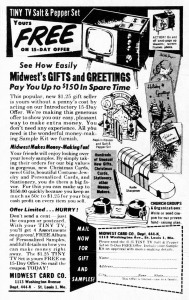
The Midwest Card Company tempted customers with a gift with purchase in September 1957—a whimsical miniature TV console salt and pepper set worth $1.25 with their introductory 15-day door-to-door selling kit. In July 1960, Harden’s in Sullivan, Illinois offered the same set free with the purchase of a $1 or more of Charmcraft greeting cards. Davis Paint, in Bristow, Oklahoma offered the salt and pepper set for 57-cents to get customers into its store. This unique novelty TV console features salt and pepper shakers that pop out when the large knob is turned, and the TV screen can hold photos. It was promoted as a perfect “TV set” for dollhouses, too. Clever! The TV console salt and pepper sets were made in the USA, but no manufacturer has been identified.
References: Midwest Card Company Advertisement, The Salisbury Post (Salisbury, North Carolina), September 15, 1957; Davis Paint Advertisement, The Bristow News (Bristow, Oklahoma), December 4, 1958; Harden’s Advertisement, News Progress (Sullivan, Illinois), July 14, 1960.

Miniature Mixer Salt and Pepper Set with Detachable Bowl for Sugar

In 1957, Harvey Doehla and Associates door-to-door greeting card sales plan promised “extra money the year ‘round” and a miniature mixer salt and pepper set that was yours to keep. “Top tilts back like a real electric mixer, so shakers (the “beaters”) can easily be removed. Bowl lifts out, too—can be used for sugar! Stands about 5 inches high. Made of glistening white and black Styron plastic. Sells regularly for $125— but yours for only 25-cents on this Special Introductory Offer!” is how Doehla described their clever new salt and pepper set. Doehla’s miniature mixer salt and pepper closely resembled Sunbeam’s Mixmaster but was not marketed as such. It was packaged in a brightly colored, graphic box, and was made in the USA, but the manufacturer is unknown.
References: Harvey Doehla and Associates Advertisement, Sun Herald (Biloxi, Mississippi), July 20, 1957
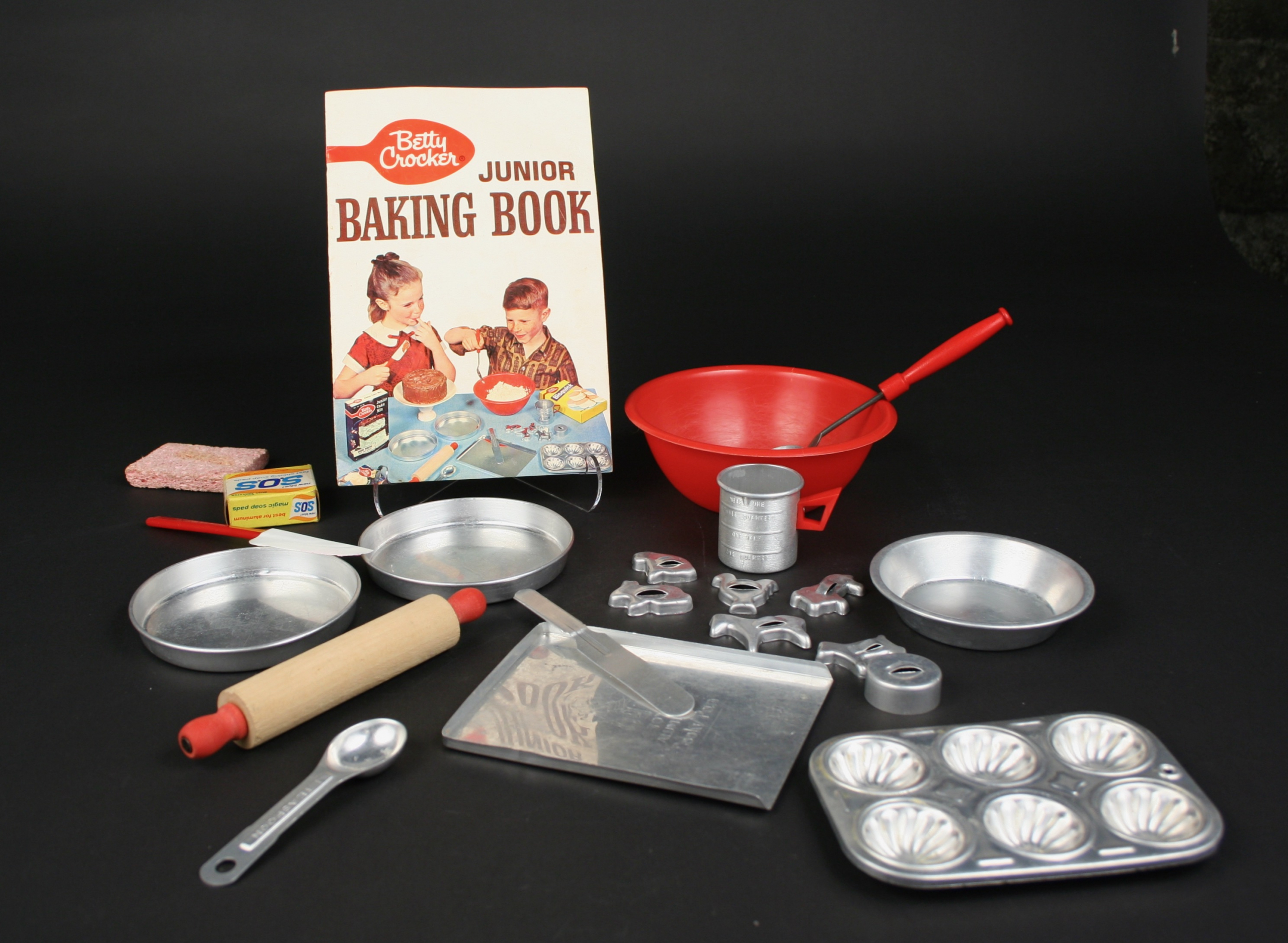
Ideal—General Mills Betty Crocker Junior Baking Kit

“There’ll be a new cook in the kitchen now…and before you know it your Junior baker will be turning out tasty pastries…almost as good as mom’s. Little boys and girls have always like to play at cooking and baking…now Betty Crocker makes the real thing possible.” And in October 1953, just in time for the holiday season, Ideal Toy Corporation introduced the Betty Crocker Junior Baking Kit. The original Betty Crocker Junior Baking Kit included 21 Mirro baking utensils, 12 Betty Crocker baking mixes and frostings, and Betty Crocker’s Junior Backing Book with step-by-step instructions. The kit included a mixing bowl, muffin and pie pan, cake pans, cookie sheet measuring cup and seven cookie cutters in animal shapes. The baking kit, priced at $4.98, was “designed to give budding pastry chefs and incentive and outlet or their creative culinary urge,” and was one of a few products of its kind to be marketed to both girls and boys. In 1963, the kit was revised to include a mixing bowl, cookie sheet, two cake pans, cupcakes pan, pie pan, six cookie cutters, a biscuit and cookie cutter, measuring cup, mixing spoon, bowl scraper, spatula, measuring spoon, rolling pin, and sponge.
Ideal Novelty and Toy Company was founded in 1903 when Morris and Rose Michtom of Brooklyn, invented the Teddy bear. Rose had made a bear for their children, and Morris and Rose sent a similar beat to President “Teddy” Roosevelt and obtained permission to use his name for the bear. After Morris died, the name was changed to Ideal Toy Company. Ideal’s best-selling products included Betsy Wetsy, the Shirley Temple doll, games like Mouse Trap, Hands Down, and the Rubik’s Cube. The company ranked among the top three toy companies in the United States by 1971 but was sold several times in the 1980s and ceased to exist after 1997. After acquiring Kenner Products in 1967, General Mills co-branded Betty Crocker with Kenner’s Easy-Bake Oven. The Betty Crocker Junior Baking Kit was discontinued after the 1968 holiday season.
References: May Company Advertisement, The Los Angeles Times, October 18, 1953; Chatter!, Daily News (New York, New York), October 20, 1953; Ideal Toy Corporation, Wikipedia; Kenner Products, Wikipedia.
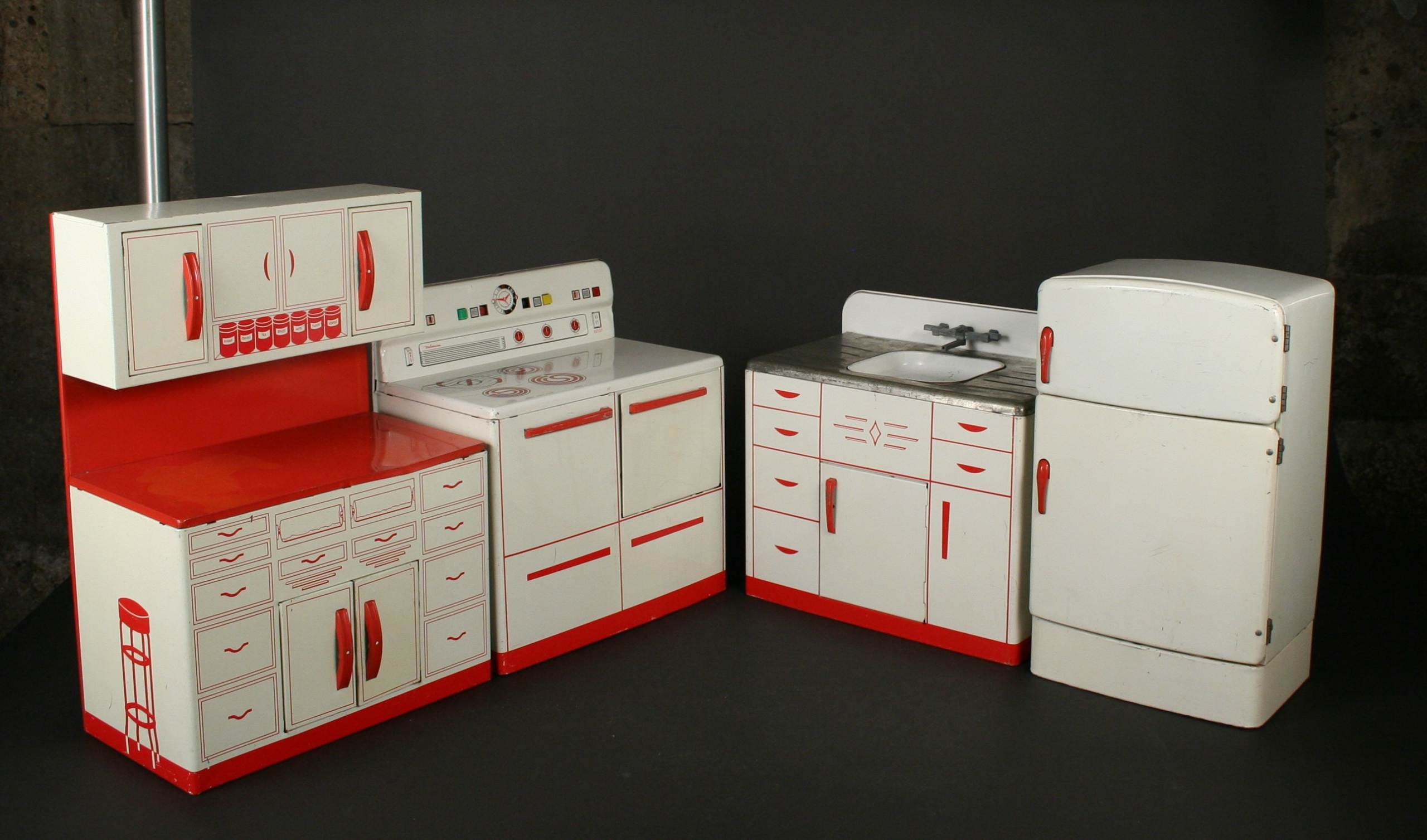
Wolverine Kitchen Set—Wolverine Supply & Manufacturing Company
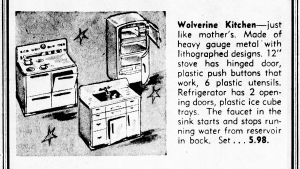
In 1947, the Wolverine Kitchen Set was introduced featuring “Play-appealing, real-life appliances!” Made of heavy gauge metal with lithographed details, the Wolverine Kitchen Set was designed for realistic play. The stove has a hinged door with plastic push buttons that work. The refrigerator has two opening doors and colorful food cutouts and plastic ice cube trays. The sink has a faucet that starts and stops running water from a reservoir in the back. The cupboard has doors that open and a stool. The Wolverine Kitchen Set was initially priced at $4.69 for a three-piece set. Wolverine continued to sell the children’s kitchen sets through 1980, often marketing it as the Sunny Suzy Kitchen Set.
In 1903, Benjamin F. Bain, a die-maker from Michigan, founded the Wolverine Supply & Mfg. Co. in Pittsburgh, Pennsylvania. The company initially focused on making kitchen parts as a tool-and-die company and was named after the University of Michigan football team. In 1910, Wolverine was contracted to make dies for the Sandy Andy, a toy designed to move with sand. Following the inventor’s death, Bain decided to manufacture the toy in his own factory. Wolverine’s first toys were sand and marble-operated, made from tin and pressed steel. They expanded to string motor-powered toys and tin-litho kitchen appliance sets for kids, solidifying their position as a major toy manufacturer by 1920. In 1962, the company changed its name to the Wolverine Toy Company before being acquired by Spang Industries of Butler, Pennsylvania. The company moved its manufacturing operations to Booneville, Arkansas in 1971 and changed its name to Today’s Kids in 1986, shifting its focus to plastic toy production. The company closed in the 1990s.
References: Guide to the Wolverine Toy Company, Historic Pittsburg; Leiter Brothers Advertisement, The Morning Herald (Hagerstown, Maryland), November 24, 1950

Red Wing Pottery for Hankscraft Company—Hankscraft Child’s Circus Chow Food Warmers and Cups
God bless all clowns.
Who star in the world with laughter,
Who ring the rafters with flying jest,
Who make the world spin merry on its way.

In the early 1940s, Hankscraft introduced their clown design baby feeding set, which became an instant hit due to children’s natural delight in happy clowns. In 1943, a 3-piece set, including a clown-shaped food warmer, a ceramic cup with a clown design and a color-matching spoon was priced at $2.95. The warmer featured double ceramic walls to keep the food warm and the water hot, which was added to the warmer through an opening with a clown head stopper. Hankscraft described the warmer as, “a great convenience, a most popular gift.” It was available in pink, turquoise, lavender, and blue. The clown design warmer was also sold separately in 1951 for a $1.99.
Hankscraft partnered with Red Wing Potteries Inc. of Red Wing, Minnesota to design and manufacture their ceramic clown design food warmer and cup. Charles Murphy, Red Wing’s design director, created the warmer and cup. Over the years other pottery companies made ceramic items for Hankscraft, but Red Wing production is marked with a unique number and logo on the bottom. Hankscraft started in 1920 with the invention of an electric egg cooker, patented by company founder Marshall Hanks. The company expanded its product line in the 1930s to include baby bottle warmers, sterilizers, and vaporizers. Originally based in Madison, Wisconsin, Hankscraft moved to Reedsburg, Wisconsin, and was incorporated in 1949. Today, the company manufactures water treatment components, P.O.P displays, and beverage tap handles.
References: Hankscraft: Who We Are. Hankscraft website; Hankscraft Food Warmer Packaging, eBay, English Rose Antiques America; Morris-Dickson Drug Stores Advertisement, The Times (Shreveport, Louisiana), October 8, 1943; Bowen’s Advertisement, Casper Star-Tribune (Wyoming), December 4, 1951; Red Wing Art Pottery, Ray Reiss, Marathon Communications, Wausau, Wisconsin, 1996; A Prayer for Clowns, Author Unknown, Poem
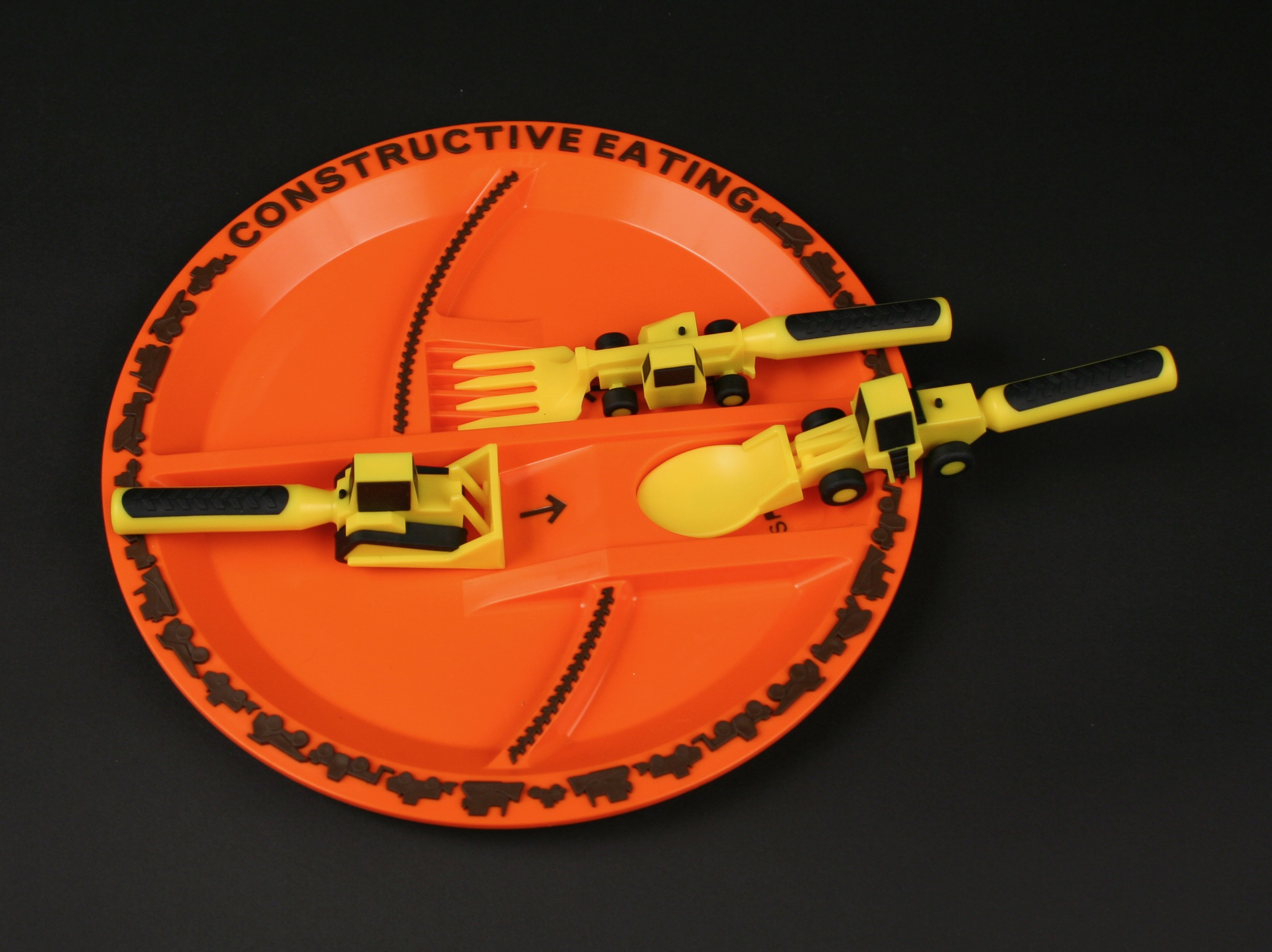
Constructive Eating, Inc—4-Piece Construction Utensil and Plate Combo
At Constructive Eating, their motto is “Feed Kids Creatively.” Carter and Jackie Malcolm’s journey began when their son developed a passion for construction, turning their home into a construction site with toy trucks and equipment everywhere. One day, they found their son using his cereal as rubble for his toy bulldozer, which inspired the creation of Construction Eating’s first fleet of truck utensils and construction site plate. The idea has expanded into various coordinating, award-winning products, such as dinosaur, garden fairy and training plates which are praised by medical professionals, parents, and kids alike. Now rev up that bulldozer and get eating!
Reference: About Us, Constructive Eating website; Construction Utensil and Plate Combo, Constructive Eating website.

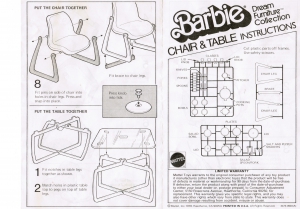
IMoDD has in its permanent collection a set from the Barbie® Dream Furniture Collection, including a table and chairs with plates, glasses, cooking pots, and utensils. The set is copyright 1977. It came with no dolls and had to be assembled (probably by the parent). The instructions from Mattel Toys that were included with the set stated “Cut plastic parts off frames. Use safety scissors.” No box came with this IMoDD set, but the box claimed “Room after room of furniture, year after year of play – the Barbie(R) Dream House has everything a little girl dreams of!” While we all learned from the super popular Barbie® movie that she loved pink, this set is in complimentary turquoise with pink highlights.
According to Britannica, the fashion doll Barbie® officially debuted on March 9, 1959, at the American International Toy Fair in New York City. It was created by Ruth Handler at Mattel, Inc. She was apparently inspired by the German Lilli doll in 1956. The first Barbie® was sold in 1958. During that first year 300,000 dolls were sold. While Barbie has had over 20 different dream houses over the years, her dishes have remained remarkably traditional.
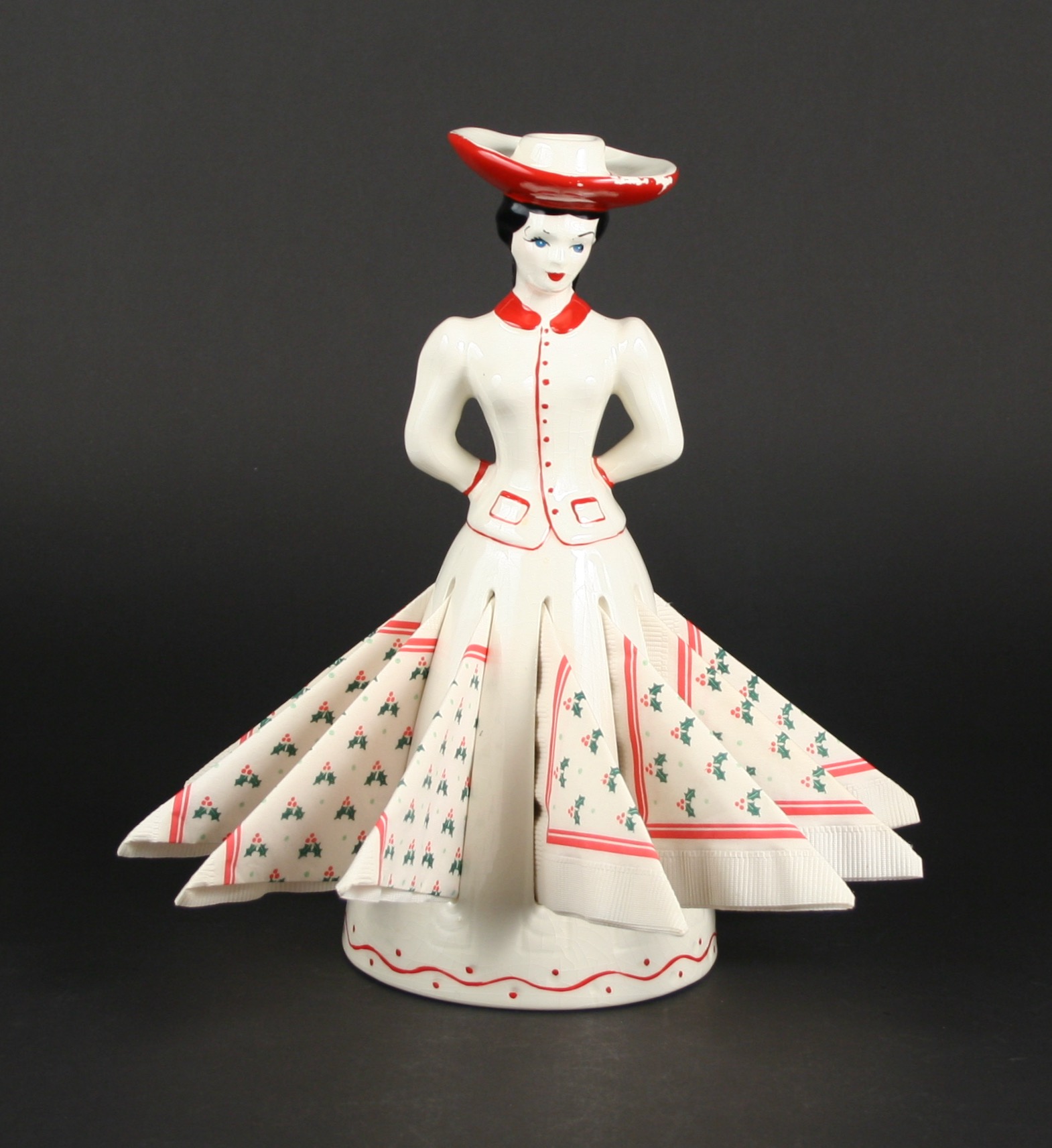
California Originals created napkin ladies in the 1940s-1950s. Each is mold made with different glaze colors applied, but they are uniformly clunky in their ceramic forms. While they clearly fall into the category of dining kitsch, they add a playful aspect to where napkins can reside on the table or counter; a clear departure from generally characterless, conservative napkin holders. Each napkin lady has a personality or flavor of her own. She might be a cowgirl or a princess.
California Originals was located in Manhattan Beach, California. According to the website Francine’s Figurines, this company originated in 1945 as Heirlooms of Tomorrow and at that time their output was largely fine quality porcelain figurines. It was after their move to Torrance, California, at an unknown date, that the name changed to California Originals, and the “figurines” were no longer fine and delicate in a Victorian style.
While they manufactured more than napkin ladies, the business closed in 1982.


